Evolving research directions in Surface Ocean–Lower Atmosphere (SOLAS) science
Cliff S. Law A M , Emilie Brévière B , Gerrit de Leeuw C D , Véronique Garçon E , Cécile Guieu F , David J. Kieber G , Stefan Kontradowitz B , Aurélien Paulmier E H , Patricia K. Quinn I , Eric S. Saltzman J , Jacqueline Stefels K and Roland von Glasow LA National Institute of Water and Atmospheric Research (NIWA), Evans Bay Parade, Kilbirnie Wellington, 6002, New Zealand.
B GEOMAR Helmholtz-Zentrum für Ozeanforschung, Düsternbrooker Weg 20, D-24105 Kiel, Germany.
C Climate Change Unit, Finnish Meteorological Institute, PO Box 503, FI-00101 Helsinki, Finland,
D Department of Physics, University of Helsinki, PO Box 64, FI-00014 Helsinki, Finland.
E Laboratoire d’Etudes en Géophysique et Océanographie Spatiales (LEGOS), CNRS-IRD-CNES-UPS, 14, avenue Édouard-Belin, F-31401 Toulouse Cedex 9, France.
F Laboratoire d’Océanographie de Villefranche (LOV), CNRS-UPMC, BP 28, F-06234 Villefranche-sur-mer Cedex, France.
G State University of New York, College of Environmental Science and Forestry, 1 Forestry Drive, Syracuse, NY 13210, USA.
H Instituto del Mar del Perú (IMARPE), Esquina de Gamarra y General Valle S/N Chucuito, Callao, Peru.
I NOAA, Pacific Marine Environmental Laboratory, 7600 Sand Point Way NE, Seattle, WA 98115, USA.
J University of California–Irvine, 3325 Croul Hall, 3100, Irvine, CA 92697, USA.
K University of Groningen, Ecophysiology of Plants, Centre for Ecological and Evolutionary Studies, PO Box 11103, NL-9700 CC Groningen, the Netherlands.
L University of East Anglia, School of Environmental Science, Norwich Research Park, Norwich, NR4 7TJ, Norfolk, UK.
M Corresponding author. Email: cliff.law@niwa.co.nz

Cliff Law is a Principal Scientist in the Ocean and Atmosphere Centres at the National Institute of Water and Atmospheric Research (NIWA) in Wellington, New Zealand, and the NIWA Centre for Chemical and Physical Oceanography at the University of Otago. He is a marine biogeochemist who has participated in ~40 research voyages and (co-)authored 85 papers on ocean–atmosphere exchange and nutrient and physical controls on primary production. He has been a member of the SOLAS Scientific Steering Committee since 2007. |

Emilie Brévière is the SOLAS International Project Office Executive Officer since 2008, based at GEOMAR Helmholtz Centre for Ocean Research in Kiel, Germany. She is a marine biogeochemist holding a Ph.D. from the University Pierre et Marie Curie in Paris, France and a French engineering diploma in chemistry and chemical engineering from the Ecole Nationale Superieure de Chimie de Mulhouse, France. |

Gerrit de Leeuw holds a professorship in the field of Satellite Remote Sensing of Aerosol Physical and Optical Properties at the University of Helsinki and at the Finnish Meteorological Institute (FMI), Finland, since 1 January 2007. He has (co-)authored ~135 peer-reviewed articles in the fields of aerosols, remote sensing and ocean–atmosphere interaction and co-edited a book on Aerosol Remote Sensing over Land. He has participated as principal investigator in 22 EU projects (3 as coordinator), 14 ESA projects (2 as coordinator, 1 as science leader) and many other (inter)national research projects. |

Véronique Garçon is a Senior Scientist at LEGOS-CNRS in Toulouse, France. She obtained a Ph.D. at University Paris 7 and did her post-doc at MIT. She is Team leader on Physical Dynamics/Marine Biogeochemistry at LEGOS. She has been very active in the JGOFS SSC with thematics of interest related to the oceanic carbon cycle, biogeochemical cycles of nitrogen, phosphorus, oxygen, in the climate change context, and to biogeochemical climatic monitoring using synergistically different approaches: remote sensing, modelling, and experimental work. She initiated the OMZ-EBUS SOLAS Mid-Term Strategy with A. Paulmier, and has been acting as SOLAS vice chair since 2011. |
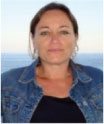
Cécile Guieu is a Senior Scientist at Centre National de la Recherche Scientifique and works at Laboratoire d’Océanographie in Villefranche sur Mer (LOV), France. She is a marine biogeochemist and her research focuses on atmospheric inputs of nutrients and particles and how they affect marine biogeochemical cycles and carbon export. She is a member of the SOLAS Scientific Steering Committee since 2009. |

David Kieber is a Professor of Chemistry at the State University of New York, College of Environmental Science and Forestry in Syracuse, New York. He received his Ph.D. from the University of Miami, Rosenstiel School of Marine and Atmospheric Science in 1988, and held a postdoctoral position at the Woods Hole Oceanographic Institution from 1989 to 1990. His research program is focussed on the study of biological, geochemical and photochemical transformations of naturally occurring organic matter in atmospheric and aquatic environments, and the resultant effects of these transformations on the global biogeochemical cycles of carbon, nitrogen, sulfur and phosphorus, especially as they are affected by climate change. He has been a member of the SOLAS Scientific Steering Committee since 2007. |

Stefan Kontradowitz graduated from the University of Kiel in 2009 with a Degree in Physical Geography. After graduating he briefly worked for a space science journal before taking a job as a Research Assistant at GEOMAR Helmholtz Centre for Ocean Research in Kiel where he was introduced to the work of SOLAS. Since early 2011, he has been the Project Officer for the SOLAS International Project Office concentrating on planning and organising the SOLAS Open Science Conferences, SOLAS Summer Schools and Workshops. |

Aurélien Paulmier is a Junior Scientist at IRD/LEGOS in Toulouse, France. He did his National Service as a research engineer in Chile, obtained a Ph.D. at Paris VI and has had several post-doctoral positions at IFM-Geomar in Kiel and MPI in Bremen. He is currently working in cooperation in Lima (Peru) and is co-initiator of the OMZ-EBUS SOLAS Mid-Term Strategy. Since 1999–2000, he has studied the impact and feedback effects of climate change on marine biogeochemistry, focussing on Oxygen Minimum Zones (OMZs). His activities contribute to the development of the key thematic of ocean deoxygenation, using complementary approaches (in-situ observations, experiments, data analysis, modeling). |

Patricia Quinn is a Research Chemist at NOAA’s Pacific Marine Environmental Laboratory located in Seattle, Washington. Patricia’s research is focussed on the effect of atmospheric aerosol particles on air quality and climate. She has participated in research cruises since 1986 studying a broad range of aerosol types from remote marine aerosol in the Arctic and Antarctic, and pollution aerosol in the Houston Ship Channel and the Sacramento River. She has been a member of the SOLAS Scientific Steering Committee since 2010. |
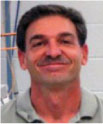
Eric Saltzman is a Professor of Earth System Science at the University of California, Irvine and the current Chair of the SOLAS Scientific Steering committee. He is an atmospheric chemist whose research involves the biogeochemical cycling of climate active trace gases. His research interests include air–sea gas transfer, assessing the reactivity of marine air, and using polar ice cores to reconstruct long term changes in atmospheric composition. |
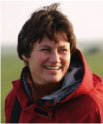
Jacqueline Stefels is Senior Scientist and lecturer at the University of Groningen, the Netherlands, within the group Ecophysiology of Plants. She is a marine phytoplankton biologist. Her research interests are the biological and environmental chemistry of dimethylsulfide and related compounds in oceans and sea-ice, the role of S-compounds in phytoplankton physiological adaptation to environmental stress and climate modelling. She is member of the SOLAS Scientific Steering Committee and co-chair of SCOR-WG140 on Biogeochemical Exchange Processes at the Sea-Ice Interfaces (BEPSII). |

Roland von Glasow is a Professor of Atmospheric Science in the School of Environmental Sciences at the University of East Anglia. He is researching tropospheric multiphase chemistry with a focus on the chemistry and relevance of reactive halogens. He develops and applies numerical models and has so far worked extensively on the marine boundary layer, the polar boundary layer, volcanic plumes and salt lakes. He is co-chair of the SOLAS/IGAC task ‘Halogens in the Troposphere’ and has been a member of the SOLAS Scientific Steering Committee since 2010. |
Environmental Chemistry 10(1) 1-16 https://doi.org/10.1071/EN12159
Submitted: 19 October 2012 Accepted: 10 December 2012 Published: 12 March 2013
Journal Compilation © CSIRO Publishing 2013 Open Access CC BY-NC-ND
Environmental context. Understanding the exchange of energy, gases and particles at the ocean–atmosphere interface is critical for the development of robust predictions of, and response to, future climate change. The international Surface Ocean–Lower Atmosphere Study (SOLAS) coordinates multi-disciplinary ocean–atmosphere research projects that quantify and characterise this exchange. This article details five new SOLAS research strategies – upwellings and associated oxygen minimum zones, sea ice, marine aerosols, atmospheric nutrient supply and ship emissions – that aim to improve knowledge in these critical areas.
Abstract. This review focuses on critical issues in ocean–atmosphere exchange that will be addressed by new research strategies developed by the international Surface Ocean–Lower Atmosphere Study (SOLAS) research community. Eastern boundary upwelling systems are important sites for CO2 and trace gas emission to the atmosphere, and the proposed research will examine how heterotrophic processes in the underlying oxygen-deficient waters interact with the climate system. The second regional research focus will examine the role of sea-ice biogeochemistry and its interaction with atmospheric chemistry. Marine aerosols are the focus of a research theme directed at understanding the processes that determine their abundance, chemistry and radiative properties. A further area of aerosol-related research examines atmospheric nutrient deposition in the surface ocean, and how differences in origin, atmospheric processing and composition influence surface ocean biogeochemistry. Ship emissions are an increasing source of aerosols, nutrients and toxins to the atmosphere and ocean surface, and an emerging area of research will examine their effect on ocean biogeochemistry and atmospheric chemistry. The primary role of SOLAS is to coordinate coupled multi-disciplinary research within research strategies that address these issues, to achieve robust representation of critical ocean–atmosphere exchange processes in Earth System models.
Introduction
The exchange of energy, gases and particles across the air–sea interface is controlled by a variety of biological, chemical and physical processes that operate across a broad range of spatial and temporal scales. These influence the composition and biogeochemical processes of both phases and ultimately interactions and feedbacks with the climate system. The significance of this exchange across the air–sea interface is readily apparent in global budgets; for example, the oceans have taken up ~48 % of the anthropogenic CO2 released into the atmosphere since the late 18th century,[1] and 90 % of the total energy increase in the air–sea–land–cryosphere climate system (1961–2003).[2] The ocean also accounts for 50 % of global oxygen production,[3] and annually receives 500 Mt of terrestrially derived dust and aerosols.[4] The magnitude and variability of air–sea fluxes and associated control processes are the focal point for the Surface Ocean–Lower Atmosphere Study (SOLAS), a multi-disciplinary international project involving 1900 scientists from 75 countries. Initiated in 2004, the aim of SOLAS is the ‘quantitative understanding of the key biogeochemical–physical interactions and feedbacks between the ocean and the atmosphere, and of how this coupled system affects and is affected by climate and environmental change’. The SOLAS Science Plan and Implementation Strategy (SP&IS)[5] promoted coupled studies between ocean and atmosphere in three focus areas: (i) biogeochemical interactions and feedbacks between the ocean and atmosphere; (ii) exchange processes at the air–sea interface and the role of transport and transformation in the atmospheric and oceanic boundary layers and (iii) air–sea flux of CO2 and other long-lived radiatively active gases (see Fig. 1). The overarching research strategy of the SOLAS SP&IS subsequently stimulated a wide range of experiments and field observations that have increased process-orientated understanding and improved the representation of biogeochemical processes in Earth System models.

|
There have been major advances in our knowledge of ocean–atmosphere exchange processes in the last decade.[6] The significance of air–sea exchange to marine nutrient budgets has been established for nitrogen,[7] iron[8,9] and phosphorus.[10] Large databases, such as SOCAT (CO2), MEMENTO (nitrous oxide (N2O) and methane),[11] and GSS (dimethyl sulfide, DMS) have supported the development of global climatologies,[12] reassessment of regional and global ocean sinks and sources[13,14] and development of prognostic models.[15] Studies of physical processes have produced new parameterisations and algorithms[16–19] and remote sensing approaches[20] for quantifying air–sea exchange. Observational frameworks and predictive models have increased in coverage, complexity and robustness,[21–23] which is critical for establishing mitigation and adaptation responses to climate change. SOLAS research has also become increasingly more relevant to environmental policy in areas such as ocean acidification,[24] iron fertilisation and geoengineering.[25–28]
As predicted in the SP&IS new challenges have arisen in this rapidly evolving field of research that now require reassessment of the SOLAS research aims. In 2008 the SOLAS Scientific Steering Committee indentified several unresolved issues of significance to the global climate system that would benefit from additional international coordination and networking. These ideas subsequently evolved in a series of white papers that articulated research priorities and identified optimal frameworks and solutions for improved understanding in these novel cross-cutting areas. In the following sections the status of these issues is reviewed with details of the research strategies required to address them, with an appendix of acronym and abbreviation definitions at the end of the article. The five research strategies, two of which are regionally based with the remainder issue based, do not represent an exclusive list of SOLAS research topics but instead focus on areas where international coordination by SOLAS can deliver major advances. Other active areas of SOLAS research, such as ocean carbon and ocean acidification research coordination, are not covered by these strategies, as support mechanisms already exist (e.g. the SOLAS–IMBER carbon working group). The five new research strategies complement the research aims of the SP&IS (see Fig. 1), and maintain the SOLAS focus on multi-disciplinary coupled ocean and atmosphere research. As such they contribute to the goals of the IGBP AIMES project, and represent an important step towards the understanding of climate–ecosystem interactions required for the Future Earth Initiative (http://www.icsu.org/future-earth, accessed 26 February 2013).
Air–sea gas fluxes at eastern boundary upwelling systems and oxygen minimum zones
Eastern boundary upwelling systems (EBUSs) are characterised by high biological activity and heterotrophy that, in combination with weak ventilation, leads to the formation of oxygen minimum zones (OMZs) in sub-surface waters. The latter are characterised by intense suboxic waters that extend from shallow depths over several hundred metres of the water column and that support major perturbation of marine biogeochemical cycles (Fig. 2). Surface waters in EBUSs are characterised by high trace gas and CO2 emissions, elevated nutrients and low pH,[29] as a result of upwelling of subsurface water that has experienced high levels of heterotrophy, and so influence climate, cloud properties and marine productivity. OMZs contribute to the cycling of climate reactive trace gases,[30] including methane and hydrogen sulfide,[31,32] and represent the primary open ocean regions for fixed nitrogen loss, N2O production[33] and emission of reactive halogen compounds.[34,35] However, feedback effects of OMZs are complex and currently largely unquantified. Stramma et al.[22] have shown that OMZs are expanding in the equatorial Pacific and eastern tropical Atlantic with decreasing dissolved oxygen concentrations between 300- and 700-m depth over the last 50 years. In contrast to these observations, most models predict an increase in oxygen concentrations in the tropical thermocline with an associated reduction in the extent of suboxic areas in 21st century projections.[36,37] The tendency towards higher oxygen concentrations in model scenarios of the future tropical thermocline may reflect the mixing intensity employed in the models.[38] Nevertheless, as ocean warming, acidification and deoxygenation will act synergistically as stressors on marine ecosystems,[39,40] further insight is required into the functioning of OMZs.
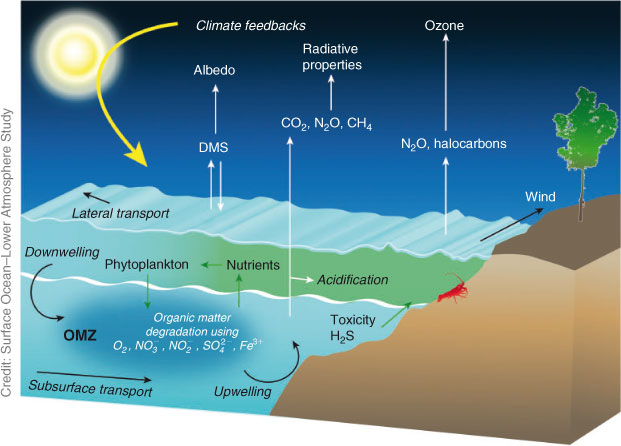
|
An articulated international project has been developed to address these issues that builds upon collaboration with other IGBP projects (IMBER, IGAC and PAGES), GEOTRACES and CLIVAR. The proposed research will focus primarily on the OMZ in the Eastern Tropical South Pacific, and examine issues relating to reactivity and climate feedbacks. Although EBUSs represent a source of CO2, N2O and methane to the atmosphere it is unclear how these emissions are coupled,[41] and as such what is the magnitude of their net radiative forcing and associated climate effect. EBUSs also influence tropospheric and stratospheric ozone by production of halogen compounds and N2O, and atmospheric albedo by intensified DMS production or consumption,[42] with further indirect feedbacks to the climate system. Factors such as the degree of physical mixing and connection with equatorial circulation, and organic matter supply will determine the respiratory status of an OMZ. This will then influence the relative magnitude of heterotrophic processes along a gradient from aerobic remineralisation through denitrification and sulfate reduction to suboxic mechanisms using other electron acceptors (e.g. IO3–, MnO2 and Fe3+) and methanogenesis. The relative spatial extent and temporality of these respiration processes and the factors that determine their distribution and magnitude need to be established, to determine the net effect on CO2 and trace gas production and emission from EBUSs, and hence the magnitude of feedbacks to climate change.
Initial research missions will focus on acquiring short- and long-term data from a variety of platforms (research cruises, laboratory experiments, moorings and glider networks, ARGO floats, ASIP and aircraft) to contribute to historical and new databases (SOCAT, MEMENTO and potentially a H2S database), remote sensing and analysis. In parallel there will be development of parameterisations, coupled biogeochemical–physical–atmospheric models, new numerical tools and large-scale validations. This will also involve regional comparisons between the Atlantic and Pacific EBUSs, which exhibit some differences. For example, Mauritanian EBUSs tend to have weaker N2O emissions, lower denitrification and negligible hydrogen sulfide emissions.[43] There are also other critical regional differences including aeolian dust deposition, which is high off North-west Africa but low in the Tropical East Pacific, and the additional influence of benthic–pelagic coupling in the Mauritanian EBUS as a result of the overlap of the OMZ with the continental shelf. Field activities have already been initiated, with science flights (TORERO) coupled with research cruises (EqPOS, SFB754, AMOP), and synoptic remotely sensed data collection (ESA OceanFlux). Complementary autonomous platforms, including fixed position moorings for time-series datasets, gliders and AUVs for submesoscale coverage, and Lagrangian profiler floats, will provide localised data collection. Regional high resolution coupled biogeochemical–physical and ocean–atmosphere models will achieve coupling between differing spatial scales and complement data collection and interpretation.
Sea-ice biogeochemistry and interactions with the atmosphere
Sea ice plays an important role in the cycling and exchange of climate relevant gases, and consequently the observed and predicted decline in sea-ice cover has implications for regional biogeochemistry and climate change (Fig. 3). Climate related feedbacks may occur in response to changes in the surface area of both ice sheets and open water. However our understanding of these processes is still in its infancy and so associated models currently contain a high degree of uncertainty. Due to inherently different properties of the polar regions, climate change affects the Arctic and Southern Ocean in different ways. In the Arctic, both sea-ice extent and thickness are reducing rapidly, with a new record low summer ice extent in 2012 (http://nsidc.org/news/press/20121002_MinimumPR.html, accessed 26 February 2013) and dramatic shifts from multi-year ice to first-year ice. Conversely a modest increase of total sea-ice extent has been observed in the Antarctic but with significant regional variability, with major reductions in sea-ice extent along the west coast of the Antarctic Peninsula[44] associated with dramatic shifts in plankton biomass and diversity.[45] With the ongoing rapid changes, it is important to realise that although sea ice may not completely disappear, it will undergo a profound change in seasonality with feedbacks to regional biogeochemical and physical properties.
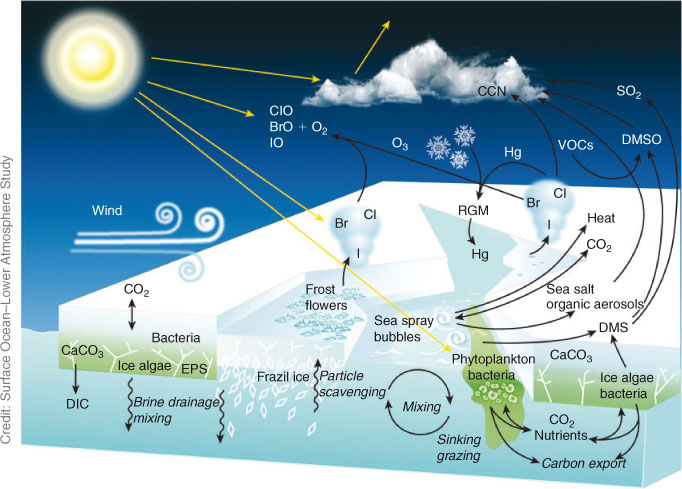
|
Current global models include the seasonal wax and wane of sea ice but representation of associated properties is limited to a few physical features, and biogeochemical effects are poorly represented. In such models, the major climatic effects of sea ice are associated with albedo, deep water formation and air–sea heat exchange, with sea ice generally represented as a ‘lid’ that suppresses gas exchange across the ocean surface.[46] Although simulations have been developed that resolve biogeochemical cycles within sea ice,[47] many of these models are one-dimensional and trace gases are yet to be included. In many respects, Earth System models contain significant uncertainties in polar regions. For example, observed reductions in Arctic sea ice appear to be accelerated with respect to current model forecasts.[48] In addition, simulations of primary production are systematically less realistic in polar regions compared with the rest of the ocean,[49,50] with disagreement in the sign of the change predicted for primary production in end-of-century scenarios for the Arctic Ocean.[50] Although sea ice reduces the surface area available for air–sea fluxes, processes such as turbulent ice–ocean and ice–air interfacial stresses, buoyant convection and wind waves potentially increase gas transfer in leads and cracks above that expected over a continuous, quiescent ice cover.[51] The effect on the air–sea exchange of CO2 of a reduction in ice cover is therefore uncertain, as illustrated by contrasting estimates of an increase[52] and decrease,[53] in associated ocean CO2 uptake. Clearly these model studies are limited by insufficient representation of gas fluxes in ice-covered regions.
The IPY initiated several large-scale projects that focussed on the interaction of biotic and abiotic processes at the sea–ice and air–ice interfaces. One of the primary findings of the initial research was that physical, chemical and biological processes interact in distinct and complex ways, and cannot be studied independently.[54] For instance, the sea-ice microbial community alters the microstructure and albedo of sea ice, produces organic aerosols that function as cloud condensation nuclei (CCN)[55] (see next section) and climatically active trace gases, such as DMS and halocarbons, that alter the oxidising capacity of the atmosphere and remove ozone in the lower troposphere in spring.[56–58] In addition, physical forcing and changes in UV light influence the chemical and biological processes involved in the production of DMS and CO2.[59,60]
As Arctic sea ice retreat continues, anthropogenic pressure on polar systems will increase. An increase in ship traffic (see Ship plumes section below) and resource development will elevate pollutant loading from sulfur, nitrogen oxides and black carbon emissions, influencing atmospheric and sea-ice albedo, and tropospheric chemistry. A robust scientific understanding of feedback processes between anthropogenic activities and the polar environment from local to global scales is necessary to assist policymakers in the development of effective management strategies for polar environments. The rate at which the Arctic is currently changing requires both rapid advances in understanding and the development of robust models by international collaboration. A SCOR working group, BEPSII, has been recently initiated in which SOLAS and a second phase of the OASIS project will collaborate to address these issues. The aim of BEPSII is to promote collaboration between experimentalists and modellers from biological, chemical and physical disciplines, with emphasis on those working at the ice–ocean–atmosphere interfaces. Two important goals are the standardisation of sea-ice measurement methodologies to improve future data intercomparisons and summaries of existing knowledge for prioritising processes and model parameterisations. A major issue is the lack of databases on relevant time and space scales, and standardisation of databases of priority parameters is urgently needed. In this respect, a first inventory of sea-ice chlorophyll-a has been produced by ASPeCT, which may serve as a template for other databases. The ultimate goal of BEPSII is to upscale priority processes from one-dimensional to Earth System models to enable analysis of the role of sea-ice biogeochemistry in climate simulations.
Ocean-derived aerosols: production, evolution and impacts
Ocean-derived aerosols play an important role in controlling aerosol optical depth, cloud formation and properties, radiation balance and chemistry of the marine atmosphere[61,62] (Fig. 4). Wind-driven breaking waves and bubble-bursting at the sea surface inject inorganic ions (Na+, Mg2+, Cl– and SO42–) associated with seawater into the overlying atmosphere.[62–64] In addition, ocean-derived aerosols also contain inorganic and organic species produced through secondary (gas to particle conversion) processes.[65,66] Numerous studies in coastal and productive waters[67] and oligotrophic seawater[68] have identified that marine aerosol is highly enriched in organic matter (OM) relative to bulk seawater, with OM accounting for >50 % of non-water mass of particles of ≤500-nm radius.[66,68,69] However, production mechanisms, composition, chemical properties including solubility and hygroscopicity, and the contribution of ocean-derived OM to aerosol mass and number concentration are not well understood.[64]
Primary production of sea spray aerosol is the main source of aerosol mass to the atmosphere.[70] The mass concentration of ocean-derived aerosols is dominated by particles of radius >1 µm (super-micrometre), composed primarily of sea salt, with lifetimes of hours to several days, whereas the ocean-derived aerosol number production flux is dominated by particles smaller than 200-nm radius (r80, i.e. at relative humidity of 80 %),[63] with lifetimes ranging from hours to weeks.[71] Ocean-derived aerosols influence the Earth’s radiation balance by scattering and absorption of solar radiation (direct effects), and also by cloud formation and microphysical, macrophysical and optical properties (indirect effects). However observations and model estimates of the contribution of sea salt aerosol to the total (natural and anthropogenic) global short-wave direct radiative effect and the global aerosol optical depth have large uncertainties, with values ranging from 18 to 50 %.[72] Furthermore sea salt source functions used in different global models and model estimations of sea salt dry mass vary by a factor of five.[62,63,73,74]
Recent advances in understanding and quantification of emission and production mechanisms include the extension of the sea spray source function to particles with r80 of ~10 nm, which is important for the assessment of aerosol effects on clouds. Large-number production fluxes of particles with r80 of ~100 nm, and decreasing fluxes below 100 nm, have also been identified.[63] Nevertheless, large uncertainties in the number production flux remain,[63] although recent results converge within a factor of 2–3.[75] Advances have also been made in our understanding of the effect of ocean-derived aerosols on climate, particularly with respect to the effects of OM on CCN production,[76–78] and on boundary layer chemistry.[79–81] There has also been recent recognition that particles of <1 µm may be a significant source of CCN in marine regions,[70] that is potentially more important than the contribution from the oxidation of DMS.[61,82,83] Emissions and chemical processing of primary ocean-derived particulate OM are now being integrated into ocean-derived aerosol source functions,[84,85] and the effects of sea surface temperature[86] and wind-speed dependent size-resolved OM production[87,88] incorporated into global models.[88,89]
However, several fundamental questions remain. Characterisation of the magnitude of size-resolved aerosol fluxes is required, particularly in terms of temporal and spatial variation such as between coastal and open ocean regions. Both physical and biological controls on aerosol production require resolution, particularly in relation to aerosols derived from the large pool of OM in surface seawater. Satellite derived chlorophyll-a and particulate organic carbon offer some potential as proxies for parameterising ocean OM emissions,[84,85] but investigation of alternatives is warranted given the uncertainties associated with the present proxies. Measurements in different ocean regimes are required to formulate an accurate parameterisation for the incorporation of OM into ocean-derived aerosols. The relationship between ocean-derived aerosols and CCN also requires attention to establish how the chemical composition of aerosols influences both cloud-drop activation and size-resolved fluxes of ocean-derived CCN on global and regional scales. Furthermore, there is uncertainty in the relative influence of ocean and continental-derived CCN in coastal regions. To fully understand the effect of ocean-derived aerosol on climate and tropospheric chemistry, it will be important to determine how ocean-derived aerosols evolve physically and chemically, especially with respect to OM, once injected into the troposphere.
To address these questions, multi-disciplinary field campaigns are proposed in diverse oceanic (productive v. oligotrophic) regions to develop parameterisations for the production, composition and evolution of primary ocean-derived aerosols. Characterisation of surface ocean and aerosol OM will determine sources and processes of incorporation of OM into ocean-derived aerosols. Ideally these campaigns will be coordinated with satellite observations of whitecap coverage, sea surface temperature, salinity, ocean colour, waves and aerosol properties to extend local field observations to global scales. Particular focus areas include: parameterisation of sea-spray aerosol production as a function of wave breaking, seawater temperature, salinity and surfactant concentration; inter-comparison of aerosols generated in situ and in vitro in laboratory experiments to evaluate ocean-derived aerosol source function parameterisations; and characterisation of OM composition in newly formed sea-spray aerosol particles and ambient aerosols. Coupling of satellite observations with integrated multi-disciplinary field studies will further constrain the size-resolved sea-spray source functions, both with respect to physics and chemical composition. These new parameterisations will improve the accuracy in estimates of the direct and indirect effects of ocean-derived aerosols on climate, and so optimise regional and global climate models. The ultimate aim of the proposed research is to establish both direct and indirect effects of ocean-derived aerosols on the Earth’s radiation balance and tropospheric chemistry, particularly in the marine boundary layer.
Atmospheric nutrient supply to the surface ocean
Material transported in the atmosphere originates from a variety of natural and anthropogenic sources and contains both macro- and micronutrients (N, P, C, Si and trace metals including Fe and Cu), and potentially toxic elements (e.g. Cu and Pb).[90–92] Consequently deposition represents an important source of new nutrients and particles for large regions of the open ocean.[90,91] This deposition is being perturbed directly and indirectly by anthropogenic activities; for example, atmospheric pollution has greatly increased the deposition of nitrogen,[7] and the magnitude of dust deposition to the oceans has been shown to be climate dependent.[93] There is variability in the relative ratios of the major nutrients and their speciation when delivered by atmospheric deposition at both temporal and spatial scales. Furthermore, as deposited nutrients differ in both concentration and stoichiometry to that delivered by vertical supply from sub-surface waters,[94] this may modify nutrient inventories and plankton nutrient stoichiometry and biodiversity with resulting feedbacks to atmospheric CO2 (Fig. 5). Yet, despite significant experimental, field and modelling studies over the past decade,[72] the links between atmospheric deposition of nutrients, ocean productivity and feedbacks to climate are still poorly understood. Consequently, the role of atmospheric inputs remains under-represented in budgets and marine biogeochemical models (C. Guieu, O. Aumont, L. Bopp, C. Law, N. Mahowald, E. P. Achterberg, et al., unpubl. data).
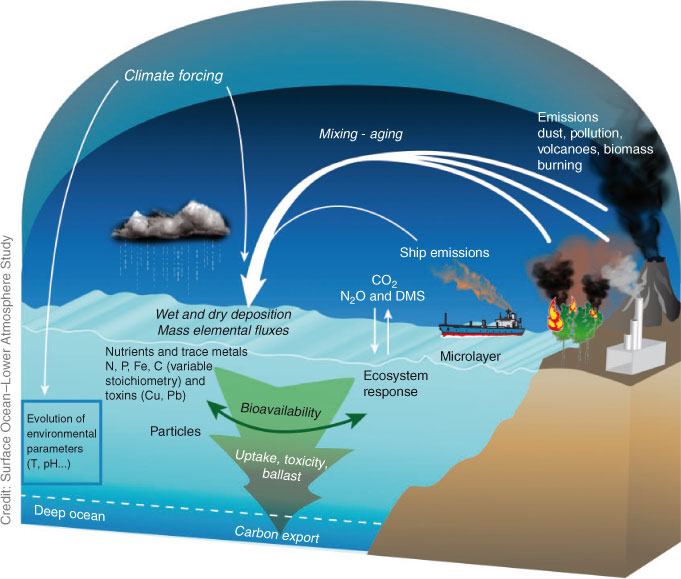
|
New observational, experimental and modelling approaches are required to characterise interactions between natural and anthropogenic atmospheric deposition, and surface ocean ecosystem community structure and biogeochemical cycling. Critical uncertainties include how the nutrient and trace metal content of natural and anthropogenic aerosols vary from initial uplift to oceanic deposition, and how processing in the atmosphere, including mixing with anthropogenic species, influences subsequent nutrient supply and availability. Emission sources, such as volcanoes, biomass burning and anthropogenic sources including ship plumes (see section below), differ in composition and spatial and temporal distribution, and so establishing how each affects ocean biogeochemistry will be key to determining variability in regional response. The effect of atmospheric deposition in the surface ocean may vary with the biogeochemical state of the receiving waters,[95] and result in fundamental differences in the response of the microbial community structure (e.g. stimulation of heterotrophy v. autotrophy[96]), and so vertical carbon export and nutrient cycling. Particle deposition to the ocean can also provide ballast for sinking particles,[97] which may augment the export flux resulting from increased nutrient supply by atmospheric deposition.[98] In addition it is currently unclear how future ocean conditions (e.g. ocean acidification, temperature and stratification) will influence the availability and reactivity of deposited material. For example, the interaction of climate forcing with changes in nutrient deposition may result in changes in both biodiversity and microorganism adaptive strategies for competing for nutrients.
Systematic measurements are required of atmospheric deposition and nutrients in the surface mixed layer in regions where atmospheric supply plays an important role,[99] as in LNLC (low-nutrient low-chlorophyll) regions (C. Guieu et al., unpubl. data) such as the South-west and North-east Pacific and Mediterranean Sea. Anthropogenic nitrogen forcing is primarily a northern hemisphere phenomenon but, as climate and ocean acidification are global drivers, there is a requirement for time-series sampling sites in both hemispheres. Although reliable measurement of dry deposition still represents a technical challenge, it will be beneficial to extend wet and dry deposition measurements and particle characterisation to repeat sampling lines across regional deposition gradients and surface water biogeochemical gradients, using research vessels and voluntary observing ships. These transects should ideally accommodate rate measurements and nutrient manipulation experiments to gain insight into the proximal controls of plankton community composition and process rates. Existing time series stations that monitor both the atmosphere and ocean (e.g. HOT, BATS, CVOO and DYFAMED) could become focal points for more detailed experiments and process studies, possibly employing Lagrangian studies using tracers or drifting buoys. Trace-element clean mesocosms and tracer-labelled in situ manipulations could also be used to address whole-ecosystem effects of atmospheric nutrient input, including particulate organic carbon export (C. Guieu et al., unpubl. data). The challenge is to assimilate this information into more realistic models of deposition and associated mechanisms, taking into account the variable stoichiometry of atmospheric nutrients and surface ocean biota, with better representation of competitive interactions between plankton groups (C. Guieu et al., unpubl. data). Transport, deposition and biogeochemical models require thorough testing and validation against in-situ time series datasets and remote-sensing observations. In addition, methodological intercalibration, sample sharing, common reference materials and standardisation of techniques are required to ensure global coherence and quality control. Linking time-series studies of aerosol composition with oceanic time-series data[99] is valuable for constraining the response of the marine ecosystem to deposition events. In addressing these goals, there is considerable mutual interest and benefit of collaborative research with the ocean-derived aerosol strategy (see section above), GESAMP[90] and the GEOTRACES project.[100]
Ship plumes: impacts on atmospheric chemistry, climate and nutrient supply to the oceans
Emissions of trace gases, primarily NOx and SO2, and particles from ocean-going ships have major effects on photochemistry in the marine boundary layer, cloud properties and aerosol direct and indirect radiative effects, and are also potentially important for the deposition of nutrients to the ocean (Fig. 6). Ship traffic has increased significantly in recent years and is projected to continue increasing.[101] In addition, new shipping routes are becoming available in the Arctic Ocean due to decreasing sea-ice cover in summer.[102] Yet, regulation of ship emissions is only just being initiated and shipping currently often relies on the use of ‘dirty’ fuels that are not used for land-based transport. The primary aim of this research strategy is to determine the regional and global effects of ship emissions on photochemistry, climate forcing and ocean biogeochemical cycling and productivity, and establish whether sub-grid scale ship plumes can be parameterised in numerical models. Ship plumes have been successfully mapped and investigated using satellite data and detailed characterisation of chemical signatures[103,104] in field campaigns such as MAST[105] and CalNEX 2010. Investigation of individual plumes and characterisation of individual ship turbines have led to important advances,[106,107] and a number of modelling studies of the effects of ship plumes on climate and atmospheric chemistry have been carried out or are ongoing.[101,108–110] These have been complemented by emissions inventories[101,111,112] and large scale assessments on climate,[113,114] health and mortality.[115] However, as yet no assessment has been carried out on the effects of deposition from ship plumes on ocean biogeochemistry.

|
For most numerical models, ship plumes are sub-grid scale (i.e. smaller than the size of grid boxes). However as many related processes, such as photochemistry, are non-linear it cannot be assumed that emissions are homogeneously distributed within a grid box as this leads to overestimation of the effects on photochemistry.[109] Alternative attempts to address this have included a box model approach,[110] a large eddy model approach[116] and a ship plume parameterisation in a regional model.[117] A promising approach is the ‘plume-in-grid’ formulation by Vinken et al.,[118] which, when incorporated in a global model, showed that ignoring these effects leads to overestimation of NOx and O3 concentrations in the North Atlantic by 50 and 10–25 % respectively. Further work is clearly required to determine how grid-scale ship plumes can be parameterised in numerical models.
Some progress has been made on quantifying regional and global effects of ship emissions on atmospheric photochemistry over the last decade. The most critical effects include ozone production in ship-plume affected regions that were formally ozone sinks,[108–110] and increases in OH concentrations leading to increased oxidation capacity and a corresponding reduction in the atmospheric lifetime of methane. Furthermore, ship emissions may induce release of reactive chlorine from sea salt,[80] which has a lifetime of several days due to multi-phase cycling.[119] As the increase in chlorine atoms is maintained for a longer period than the lifetime of the ship plume this will further reduce the atmospheric lifetime of methane. Elevated levels of formaldehyde (HCHO) in ship plumes detected by satellite[104] are probably attributable to enhanced oxidation of methane caused by elevated OH concentrations.[120] A robust assessment of these effects requires global models that include multispecies chemistry with realistic reaction rates.
Non-linearities in ship plumes are less critical for the assessment of the climate impact of ship emissions, but robust emission inventories are crucial to producing reliable studies of the climate effect of ship plumes in conjunction with state-of-the-art aerosol models. Overall, direct and indirect aerosol effects of ship emissions lead to a net negative radiative forcing (cooling), partly due to the reduced atmospheric lifetime of methane.[113,114] Current attempts to reduce the sulfur content in fuels and NOx emissions from ships may reduce pollution effects, but may also cause a shift from net cooling to net warming due to the continued release of CO2 which remains unaffected by these measures.[113] Black carbon has a positive radiative effect, which is thought to be minor,[114] although deposition of black carbon on snow could influence snow albedo and increase snow melt during the Arctic summer.
A further aspect of ship emissions is their elevated nutrient and heavy metal content, which may affect ocean biogeochemistry. Duce et al.[7] estimated that anthropogenic emissions are responsible for approximately a third of nitrogen input to the open ocean, although this estimate did not include deposition from ship emissions and so may be an underestimate. Dalsøren et al.[112] used a global transport model to calculate the contribution of ship emissions to global wet deposition and identified a respective contribution of 11 and 4.5 % to depositions of NO3– and SO42–, which increased to 25–50 and 15–25 % in coastal regions. Nitrate is an important nutrient for phytoplankton growth, but the deposition of NO3– and SO42– also increases acidification of surface waters,[121] although it has been argued that the effects of this are minor.[122] Conversely, ship fuels contain high levels of heavy metals, many of which are toxic, which may influence biodiversity and productivity of marine ecosystems.[92] A full assessment of the effect of ship emissions on ocean biogeochemistry, including the effect of nutrient v. toxin input, has yet to be undertaken but coordination with the Atmospheric Nutrient and Ocean-derived Aerosols research strategies (see previous two sections) will assist in the development of this emerging SOLAS research theme.
Summary
-
EBUSs and their associated OMZs are critical sites for greenhouse and trace gas, aerosol and nutrient cycling. These regions influence climate, cloud properties and marine productivity, yet feedbacks are complex and poorly quantified. The proposed research will determine the net radiative forcing and overall climate effect of these regions, by considering CO2 and trace gas production and emission, with a primary focus in the East Tropical South Pacific, using multiple sampling platforms to develop new databases, remote sensing, parameterisations, models, numerical tools and validation for OMZs.
-
Sea ice plays an important role in the cycling and air–sea exchange of climate relevant gases, and so the observed and predicted decline in sea-ice cover has implications for regional biogeochemistry and climate change. The goals of future research will be to examine the biological, chemical and physical controls of greenhouse and reactive trace gas cycling at the sea-ice interfaces, by coordination of international studies, to improve the representation of sea-ice biogeochemistry in models. An important aspect will be the evaluation and standardisation of currently used sea-ice methodology to improve future data intercomparison.
-
Marine aerosol particles influence atmospheric chemistry, aerosol optical depth, cloud properties and radiation balance. The aim of this strategy is to further constrain sources, particle composition and the spatio-temporal variability of ocean-derived aerosols, their effect on processes in both open ocean and coastal regions, and their contribution to aerosol radiative effects (both direct and indirect, by their effects on cloud properties). This will be achieved by campaigns and experiments in contrasting oceanic regions that will examine physical and biological influences on sea spray aerosol properties, characterise their cloud-nucleating properties and develop aerosol production parameterisations.
-
The role of atmospheric input is poorly represented in marine biogeochemical models and there is a need to determine the linkages between atmospheric deposition, nutrient availability, the response of the biota, carbon cycling and feedbacks to climate. The proposed research strategy will develop coordinated approaches to assessing the sensitivity of ocean biota to atmospheric deposition in different regions, by simultaneous observation of aerosol, flux and sea-water composition.
-
Ship emissions are a poorly characterised source of NOx, sulfate aerosols and nitrogen and influence photochemistry, reactive gas chemistry and aerosol production in the marine boundary layer, and nutrient and toxin supply to surface waters. The aims of this emerging research theme are to determine the regional and global effects of ship emissions on atmospheric chemistry, climate forcing and ocean biogeochemical cycling and productivity, and establish whether sub-grid scale ship plumes can be parameterised in numerical models.
Acronyms and abbreviations
All websites in this list were accessible as of 14 February 2013.
-
AIMES – Analysis, Integration and Modelling of the Earth System; IGBP project; http://www.aimes.ucar.edu/
-
AMOP – Activités de recherché dédiées au Minimum d’Oxygène dans le Pacifique est; French research project on development of instrumentation and sensors for understanding Oxygen Minimum Zones and deoxygenation
-
ARGO – International integrated observation program utilising free-floating profilers, http://www.argo.ucsd.edu/
-
ASPeCT (Antarctic Sea Ice Processes and Climate) – SCAR Physical Sciences program expert group on multi-disciplinary Antarctic sea ice zone research, http://aspect.antarctica.gov.au/
-
ASIP – air–sea interaction profiler
-
AUV – autonomous underwater vehicle
-
BATS – Bermuda Atlantic Time-Series Study, http://bats.bios.edu/
-
BEPSII – Biogeochemical Exchange Processes at the Sea–Ice Interfaces, SCOR Working Group, http://www.scor-int.org/Working_Groups/wg140.htm
-
CalNEX 2010 – California Nexus US multi-agency study of Air Quality and Climate Change, http://www.esrl.noaa.gov/csd/calnex/
-
CLIVAR – Climate Variability and Predictability, WCRP project, http://www.clivar.org/
-
CCN – cloud condensation nuclei
-
CVOO – Cape Verde Ocean Observatory
-
DMS – dimethyl sulfide
-
DYFAMED – Dynamics of Atmospheric Fluxes in the Mediterranean Sea Time Series Station, http://www.eurosites.info/dyfamed.php
-
ESA OceanFlux – European Space Agency Greenhouse gas project, http://www.oceanflux-ghg.org/
-
GEOTRACES – International Study of Marine Biogeochemical Cycles and their Isotopes, a SCOR project, http://www.geotraces.org/
-
GESAMP – United Nations Working Joint Group of Experts on the Scientific Aspects of Marine Environmental Protection, http://www.gesamp.org/
-
GSS – Global Surface Seawater DMS database, http://saga.pmel.noaa.gov/dms/
-
HOT – Hawaii Ocean Time-series, http://hahana.soest.hawaii.edu/hot/
-
iCACGP – international Commission on Atmospheric Chemistry and Global Pollution
-
IGAC – International Global Atmospheric Chemistry, IGBP project, http://www.igacproject.org/
-
IGBP – International Geosphere–Biosphere Programme, http://www.igbp.net/
-
IMBER – Integrated Marine Biogeochemistry and Ecosystem Research, a SCOR & IGBP project, http://www.imber.info/
-
IPY – International Polar Year, http://www.ipy.org/
-
EqPOS – Equatorial Pacific Ocean and Stratospheric–Tropospheric Atmospheric Study, Japanese SOLAS project
-
MAST – Monterey Area Ship Track (MAST) Experiment[105]
-
MEMENTO – marine nitrous oxide and methane database[11]
-
OASIS – Ocean–Atmosphere–Sea-Ice–Snowpack, http://www.acd.ucar.edu/oasis/
-
OM – organic matter
-
PAGES – Past Global Changes, IGBP project, http://www.pages-igbp.org/
-
SP&IS – SOLAS Science Plan & Implementation Strategy (2004)[5]
-
SCOR – Scientific Committee on Oceanic Research, http://www.scor-int.org/
-
SOCAT – Surface Ocean CO2 Atlas, http://www.socat.info/
-
SOLAS – Surface Ocean–Lower Atmosphere Study, http://solas-int.org/; Mid-Term Strategy White Papers, http://solas-int.org/about/mid-term-strategy.html
-
SFB754 – German Research project on climate–biogeochemical interactions in the tropical oceans, http://oceanrep.geomar.de
-
TORERO – Tropical Ocean Troposphere Exchange of Reactive halogen species and Oxygenated VOC project, http://www.eol.ucar.edu/deployment/field-deployments/field-projects/torero
-
WCRP – World Climate Research Programme, http://www.wcrp-climate.org/
Acknowledgements
The authors thank Erika McKay and support from the NIWA Atmospheres Centre for production of the concept diagrams and Kath Mortimer and Jasmin Mögeltönder of the SOLAS International Project Office for assistance. They also thank Doug Wallace for initiating the SOLAS Mid-Term Strategies, and members of the SOLAS Scientific Steering Committee and SOLAS scientists who have contributed to their development. The authors acknowledge the support provided to the SOLAS project by the International Geosphere-Biosphere Program (IGBP), the Scientific Committee on Oceanic Research (SCOR), the World Climate Research Program (WCRP), the international Commission on Atmospheric Chemistry and Global Pollution (iCACGP) and the US National Science Foundation (NSF).
References
[1] C. L. Sabine, R. A. Feely, N. Gruber, R. M. Key, K. Lee, J. L. Bullister, R. Wanninkhof, C. S. Wong, D. W. R. Wallace, B. Tilbrook, T.-H. Peng, A. Kozyr, A. F. Rios, The oceanic sink for anthropogenic CO2. Science 2004, 305, 367.| The oceanic sink for anthropogenic CO2.Crossref | GoogleScholarGoogle Scholar | 1:CAS:528:DC%2BD2cXls1egsbc%3D&md5=ae0c22ba73ce68ae835380d3f7715aaeCAS |
[2] N. L. Bindof, J. Willebrand, V. Artale, A. Cazenave, J. Gregory, S. Gulev, K. Hanawa, C. LeQuéré, S. Levitus, Y. Nojiri, C. Shum, L. Talley, A. Unnikrishnan, Observations: Oceanic Climate Change and Sea Level, in Climate Change 2007: the Physical Science Basis. Contribution of Working Group I to the Fourth Assessment Report of the Intergovernmental Panel on Climate Change 2007 (Cambridge, United Kingdom, New York, USA).
[3] C. B. Field, M. J. Behrenfeild, J. T. Randerson, P. Falkowski, Primary production of the biosphere: integrating terrestrial and oceanic components. Science 1998, 281, 237.
| Primary production of the biosphere: integrating terrestrial and oceanic components.Crossref | GoogleScholarGoogle Scholar | 1:CAS:528:DyaK1cXksFKitb0%3D&md5=4740f2ba2221baa6cffd0853f8426964CAS |
[4] Y. Shao, K.-H. Wyrwoll, A. Chappell, J. Huang, Z. Lin, G. H. McTainsh, M. Mikami, T. Y. Tanaka, X. Wang, S. Yoon, Dust cycle: an emerging core theme in Earth system science. Aeolian Research 2011, 2, 181.
[5] Science Plan and Implementation Strategy, IGBP Report Number 50 2004 (SOLAS: Stockholm).
[6] P. S. Liss, M. T. Johnson (Eds), Ocean–Atmosphere Interactions of Gases and Particles, in press (Springer: Heidelberg).
[7] R. A. Duce, J. LaRoche, K. Altieri, K. R. Arrigo, A. R. Baker, D. G. Capone, S. Cornell, F. Dentener, J. Galloway, R. S. Ganeshram, R. J. Geider, T. Jickells, M. M. Kuypers, R. Langlois, P. S. Liss, S. M. Liu, J. J. Middelburg, C. M. Moore, S. Nickovic, A. Oschlies, T. Pedersen, J. Prospero, R. Schlitzer, S. Seitzinger, L. L. Sorensen, M. Uematsu, O. Ulloa, M. Voss, B. Ward, L. Zamora, Impacts of atmospheric anthropogenic nitrogen on the open ocean. Science 2008, 320, 893.
| Impacts of atmospheric anthropogenic nitrogen on the open ocean.Crossref | GoogleScholarGoogle Scholar | 1:CAS:528:DC%2BD1cXlslygsb0%3D&md5=3f9fdac84daff679d7438ff688733eb5CAS |
[8] N. M. Mahowald, A. R. Baker, G. Bergametti, N. Brooks, T. D. Jickells, R. A. Duce, T. D. Jickells, N. Kubilay, J. M. Prospero, I. Tegen, The atmospheric global dust cycle and iron inputs to the ocean. Global Biogeochem. Cycles 2005, 19, GB4025.
| The atmospheric global dust cycle and iron inputs to the ocean.Crossref | GoogleScholarGoogle Scholar |
[9] T. D. Jickells, Z. S. An, K. K. Andersen, A. R. Baker, G. Bergametti, N. Brooks, J. J. Cao, P. W. Boyd, R. A. Duce, K. A. Hunter, H. Kawahata, N. Kubilay, J. laRoche, P. S. Liss, N. Mahowald, J. M. Prospero, A. J. Ridgwell, I. Tegen, R. Torres, Global iron connections between dust, ocean biogeochemistry and climate. Science 2005, 308, 67.
| Global iron connections between dust, ocean biogeochemistry and climate.Crossref | GoogleScholarGoogle Scholar | 1:CAS:528:DC%2BD2MXivVaqs7w%3D&md5=539926c076b012508e50a4ea4f69d68fCAS |
[10] N. M. Mahowald, T. D. Jickells, A. R. Baker, P. Artaxo, C. R. Benitez-Neslon, G. Bergametti, T. C. Bond, Y. Chen, D. D. Cohen, B. Herut, N. Kubilay, R. Losno, C. Luo, W. Maenhaut, K. A. McGee, G. S. Okin, R. L. Siefert, S. Tsukuda, Global distribution of atmospheric phosphorous sources, concentrations and deposition rates, and anthropogenic impacts. Global Biogeochem. Cycles 2008, 22, GB4026.
| Global distribution of atmospheric phosphorous sources, concentrations and deposition rates, and anthropogenic impacts.Crossref | GoogleScholarGoogle Scholar |
[11] H. W. Bange, T. G. Bell, M. Cornejo, A. Freing, G. Uher, R. C. Upstill-Goddard, G. Zhang, MEMENTO: a proposal to develop a database of marine nitrous oxide and methane measurements. Environ. Chem. 2009, 6, 195.
| MEMENTO: a proposal to develop a database of marine nitrous oxide and methane measurements.Crossref | GoogleScholarGoogle Scholar | 1:CAS:528:DC%2BD1MXht1CjurfP&md5=d1ba3de8b7a7778440bc414b00001887CAS |
[12] A. Lana, T. G. Bell, R. Simó, S. M. Vallina, J. Ballabrera-Poy, A. J. Kettle, J. Dachs, L. Bopp, E. S. Saltzman, J. Stefels, J. E. Johnson, P. S. Liss, An updated climatology of surface dimethlysulfide concentrations and emission fluxes in the global ocean. Global Biogeochem. Cycles 2011, 25, GB1004.
| An updated climatology of surface dimethlysulfide concentrations and emission fluxes in the global ocean.Crossref | GoogleScholarGoogle Scholar |
[13] A. J. Watson, U. Schuster, D. C. E. Bakker, N. Bates, A. Corbiere, M. Gonzalez-Davila, Tracking the variable North Atlantic sink for atmospheric CO2. Science 2009, 326, 1391.
| Tracking the variable North Atlantic sink for atmospheric CO2.Crossref | GoogleScholarGoogle Scholar | 1:CAS:528:DC%2BD1MXhsV2gsLvK&md5=eaf8d3a9f1fc9cbaade84ecc0696ff96CAS |
[14] T. Takahashi, S. C. Sutherland, R. Wanninkhof, C. Sweeney, R. A. Feely, D. W. Chipman, B. Hales, G. Friederich, F. Chavez, C. Sabine, A. Watson, D. C. E. Bakker, U. Schuster, N. Metzl, H. Yoshikawa-Inoue, M. Ishii, T. Midorikawa, Y. Nojiri, A. Körtzinger, T. Steinhoff, M. Hoppema, J. Olafsson, T. S. Arnarson, B. Tilbrook, T. Johannessen, A. Olsen, R. Bellerby, C. S. Wong, B. Delille, N. R. Bates, H. J. W. de Baar, Climatological mean and decadal changes in surface ocean pCO2, and net sea–air CO2 flux over the global oceans. Deep Sea Res. Part II Top. Stud. Oceanogr. 2009, 56, 554.https://doi.org/.
| Climatological mean and decadal changes in surface ocean pCO2, and net sea–air CO2 flux over the global oceans.Crossref | GoogleScholarGoogle Scholar | 1:CAS:528:DC%2BD1MXntVKjt74%3D&md5=ecaa9c8680635616aad2bf0786889cb6CAS |
[15] Y. Le Clainche, A. Vezina, M. Levasseur, R. A. Cropp, J. R. Gunson, S. M. Vallina, M. Vogt, C. Lancelot, J. I. Allen, S. D. Archer, L. Bopp, C. Deal, S. Elliott, M. Jin, G. Malin, V. Schoemann, R. Simó, K. D. Six, J. Stefels, A first appraisal of prognostic ocean DMS models and prospects for their use in climate models. Global Biogeochem. Cycles 2010, 24, GB3021.
| A first appraisal of prognostic ocean DMS models and prospects for their use in climate models.Crossref | GoogleScholarGoogle Scholar |
[16] B. J. Huebert, B. W. Blomquist, M. X. Yang, S. D. Arche, P. D. Nightingale, M. J. Yelland, J. Stephens, R. W. Pascal, B. I. Moat, Linearity of DMS transfer coefficient with both friction velocity and wind speed in the moderate wind speed range. Geophys. Res. Lett. 2010, 37, L01605.
| Linearity of DMS transfer coefficient with both friction velocity and wind speed in the moderate wind speed range.Crossref | GoogleScholarGoogle Scholar |
[17] D. T. Ho, C. S. Law, M. J. Smith, P. Schlosser, M. Harvey, P. Hill, Measurements of air–sea gas exchange at high wind speeds in the Southern Ocean: implications for global parameterizations. Geophys. Res. Lett. 2006, 33, L16611.
| Measurements of air–sea gas exchange at high wind speeds in the Southern Ocean: implications for global parameterizations.Crossref | GoogleScholarGoogle Scholar |
[18] R. Wanninkhof, W. E. Asher, D. T. Ho, C. Sweeney, W. R. McGillis, Advances in quantifying air–sea gas exchange and environmental forcing. Annu. Rev. Mar. Sci. 2009, 1, 213.
| Advances in quantifying air–sea gas exchange and environmental forcing.Crossref | GoogleScholarGoogle Scholar |
[19] C. W. Fairall, M. Yang, L. Bariteau, J. B. Edson, D. Helmig, W. McGillis, S. Pezoa, J. E. Hare, B. Huebert, B. Blomquist, Implementation of the COARE flux algorithm with CO2, DMS, and O3. J. Geophys. Res. 2011, 116, C00F09.
| Implementation of the COARE flux algorithm with CO2, DMS, and O3.Crossref | GoogleScholarGoogle Scholar |
[20] N. M. Frew, D. M. Glover, E. J. Bock, S. J. McCue, A new approach to estimation of global air–sea gas transfer velocity fields using dual-frequency altimeter backscatter. J. Geophys. Res. – Oceans 2007, 112, C11003.
| A new approach to estimation of global air–sea gas transfer velocity fields using dual-frequency altimeter backscatter.Crossref | GoogleScholarGoogle Scholar |
[21] M. Steinacher, F. Joos, T. L. Frölicher, G.-K. Plattner, S. C. Doney, Imminent ocean acidification projected with the NCAR global coupled carbon cycle climate model. Biogeosciences 2009, 6, 515.
| Imminent ocean acidification projected with the NCAR global coupled carbon cycle climate model.Crossref | GoogleScholarGoogle Scholar | 1:CAS:528:DC%2BD1MXnvVOmtbo%3D&md5=870f00ecd83a500af69d5fded9e3547cCAS |
[22] L. Stramma, G. C. Johnson, J. Sprintall, V. Mohrholz, Expanding oxygen-minimum zones in the tropical oceans. Science 2008, 320, 655.
| Expanding oxygen-minimum zones in the tropical oceans.Crossref | GoogleScholarGoogle Scholar | 1:CAS:528:DC%2BD1cXltFyisro%3D&md5=87ee2ab58ae7bbe8a311f026dc144091CAS |
[23] W. D. Collins, C. M. Bitz, M. L. Blackmon, G. B. Bonan, C. S. Bretherton, J. A. Carton, P. Chang, S. C. Doney, J. J. Hack, T. B. Henderson, J. T. Kiehl, W. G. Large, D. S. McKenna, B. D. Santer, R. D. Smith, The Community Climate System Model Version 3 (CCSM3). J. Clim. 2006, 19, 2122.
| The Community Climate System Model Version 3 (CCSM3).Crossref | GoogleScholarGoogle Scholar |
[24] M. Hood, W. Broadgate, E. Urban, O. Gaffney, (Eds) Ocean Acidification: a Summary for Policymakers from the Second Symposium on the Ocean in a High-CO2 World 2011. Available at http://www.us-ocb.org/publications/SPM-lorezv2.pdf [Verified 14 February 2013].
[25] P. W. Boyd, T. Jickells, C. S. Law, S. Blain, E. A. Boyle, K. O. Buesseler, K. H. Coale, J. J. Cullen, H. J. W. de Baar, M. Follows, M. Harvey, C. Lancelot, M. Levasseur, N. P. J. Owens, R. Pollard, R. B. Rivkin, J. Sarmiento, V. Schoemann, V. Smetacek, S. Takeda, A. Tsuda, S. Turner, A. J. Watson, Mesoscale iron-enrichment experiments 1993–2005: synthesis and future directions. Science 2007, 315, 612.
| Mesoscale iron-enrichment experiments 1993–2005: synthesis and future directions.Crossref | GoogleScholarGoogle Scholar | 1:CAS:528:DC%2BD2sXhtVyisLk%3D&md5=f61f0b74175b386614d2197b5670a736CAS |
[26] H. Browman, P. W. Boyd, Implications of large-scale iron fertilization of the oceans. Mar. Ecol. Prog. Ser. 2008, 364, 213.
| Implications of large-scale iron fertilization of the oceans.Crossref | GoogleScholarGoogle Scholar |
[27] D. W. R. Wallace, C. S. Law, P. W. Boyd, Y. Collos, P. Croot, K. Denman, P. J. Lam, U. Riebesell, S. Takeda, P. Williamson, Ocean Fertilization. A Scientific Summary for Policy Makers, IOC/BRO/2010/2 2010 (IOC–UNESCO: Paris). Available at http://unesdoc.unesco.org/images/0019/001906/190674e.pdf [Verified 14 February 2013].
[28] A.-I. Partanen, H. Kokkola, S. Romakkaniemi, V.-M. Kerminen, K. E. J. Lehtinen, T. Bergman, A. Arola, H. Korhonen, Direct and indirect effects of sea spray geoengineering and the role of injected particle size. J. Geophys. Res. 2012, 117, D02203.
| Direct and indirect effects of sea spray geoengineering and the role of injected particle size.Crossref | GoogleScholarGoogle Scholar |
[29] A. Paulmier, D. Ruiz-Pino, V. Garçon, CO2 maximum in the oxygen minimum zone (OMZ). Biogeosciences 2011, 8, 239.
| CO2 maximum in the oxygen minimum zone (OMZ).Crossref | GoogleScholarGoogle Scholar | 1:CAS:528:DC%2BC3MXntlymtr4%3D&md5=adafb9e9607b40a5f137aae56db21effCAS |
[30] A. Paulmier, D. Ruiz-Pino, Oxygen minimum zones (OMZs) in the modern ocean. Prog. Oceanogr. 2009, 80, 113.
| Oxygen minimum zones (OMZs) in the modern ocean.Crossref | GoogleScholarGoogle Scholar |
[31] R. Dugdale, J. Goering, R. Barber, R. Smith, T. Packard, Denitrification and hydrogen sulfide in Peru upwelling region during 1976. Deep-Sea Res. 1977, 24, 601.
| Denitrification and hydrogen sulfide in Peru upwelling region during 1976.Crossref | GoogleScholarGoogle Scholar | 1:CAS:528:DyaE2sXmtVKis7g%3D&md5=83530e85a4b289f23bf5e717676293caCAS |
[32] R. J. Cicerone, R. S. Oremland, Biochemical aspects of atmospheric methane. Global Biogeochem. Cycles 1988, 2, 299.
| Biochemical aspects of atmospheric methane.Crossref | GoogleScholarGoogle Scholar | 1:CAS:528:DyaK3cXksVCjtLk%3D&md5=d15f432b76ff76d8fbc809cff2252358CAS |
[33] L. A. Codispoti, J. A. Brandes, J. P. Christensen, A. H. Devol, S. W. A. Naqvi, H. W. Paerl, T. Yoshinari, The oceanic fixed nitrogen and nitrous oxide budgets: moving targets as we enter the Anthropocene? Sci. Mar. 2001, 65, 85.
| 1:CAS:528:DC%2BD38XisV2hsQ%3D%3D&md5=a8dfb96f186b1d306f47a1df0b54d689CAS |
[34] A. Saiz-Lopez, A. S. Mahajan, R. A. Salmon, S. J.-B. Bauguitte, A. E. Jones, H. K. Roscoe, J. M. C. Plane, Boundary layer halogens in coastal. Antarct. Sci. 2007, 317, 348.
| 1:CAS:528:DC%2BD2sXnslGrsrg%3D&md5=fcf6548ac1ff87fa4b1f18932d1b6dd3CAS |
[35] A. S. Mahajan, J. C. Gómez Martín, T. D. Hay, S.-J. Royer, S. Yvon-Lewis, Y. Liu, L. Hu, C. Prados-Roman, C. Ordóñez, J. M. C. Plane, A. Saiz-Lopez, Latitudinal distribution of reactive iodine in the Eastern Pacific and its link to open ocean sources. Atmos. Chem. Phys. Discuss. 2012, 12, 15541.
| Latitudinal distribution of reactive iodine in the Eastern Pacific and its link to open ocean sources.Crossref | GoogleScholarGoogle Scholar |
[36] L. Bopp, C. Le Quere, M. Heimann, A. C. Manning, P. Monfray, Climate induced oceanic fluxes: implications for the contemporary carbon budget. Global Biogeochem. Cycles 2002, 16, 1022.
| Climate induced oceanic fluxes: implications for the contemporary carbon budget.Crossref | GoogleScholarGoogle Scholar |
[37] R. J. Matear, A. C. Hirst, Long-term changes in dissolved oxygen concentrations in the ocean caused by protracted global warming. Global Biogeochem. Cycles 2003, 17, 1125.
| Long-term changes in dissolved oxygen concentrations in the ocean caused by protracted global warming.Crossref | GoogleScholarGoogle Scholar |
[38] O. Duteil, A. Oschlies, Sensitivity of simulated extent and future evolution of marine suboxia to mixing intensity. Geophys. Res. Lett. 2011, 38, L06607.
| Sensitivity of simulated extent and future evolution of marine suboxia to mixing intensity.Crossref | GoogleScholarGoogle Scholar |
[39] R. F. Keeling, A. Körtzinger, N. Gruber, Ocean deoxygenation in a warming world. Annu. Rev. Mar. Sci. 2010, 2, 199.
| Ocean deoxygenation in a warming world.Crossref | GoogleScholarGoogle Scholar |
[40] N. Gruber, Warming up, turning sour, losing breath: ocean biogeochemistry under global change. Philos. Trans. R. Soc. Lond. A 2011, 369, 1980.
| Warming up, turning sour, losing breath: ocean biogeochemistry under global change.Crossref | GoogleScholarGoogle Scholar | 1:CAS:528:DC%2BC3MXnvFSks74%3D&md5=049fedebff2b1811c5e6155b012dc165CAS |
[41] A. Paulmier, D. Ruiz-Pino, V. Garçon, The oxygen minimum zone (OMZ) off Chile as intense sources of CO2 and N2O. Cont. Shelf Res. 2008, 28, 2746.
| The oxygen minimum zone (OMZ) off Chile as intense sources of CO2 and N2O.Crossref | GoogleScholarGoogle Scholar |
[42] R. P. Kiene, T. S. Bates, Biological removal of dimethylsulphide from seawater. Nature 1990, 345, 702.
| Biological removal of dimethylsulphide from seawater.Crossref | GoogleScholarGoogle Scholar | 1:CAS:528:DyaK3cXltlyjur8%3D&md5=82afd0bc7d1f121ef48c66675d75692dCAS |
[43] E. Ryabenko, A. Kock, H. W. Bange, M. A. Altabet, D. W. R. Wallace, Contrasting biogeochemistry of nitrogen in the Atlantic and Pacific oxygen minimum zones. Biogeosciences 2012, 9, 203.
| Contrasting biogeochemistry of nitrogen in the Atlantic and Pacific oxygen minimum zones.Crossref | GoogleScholarGoogle Scholar | 1:CAS:528:DC%2BC38Xms1yqtr0%3D&md5=ef7877ff99e040dcef8fecf79d482d7cCAS |
[44] D.J. Cavalieri, C. L. Parkinson, Antarctic sea ice variability and trends, 1979–2006. J. Geophys. Res. – Oceans 2008, 113, C07004.
| Antarctic sea ice variability and trends, 1979–2006.Crossref | GoogleScholarGoogle Scholar |
[45] M. Montes-Hugo, S. C. Doney, H. W. Ducklow, W. Fraser, D. Martinson, S. E. Stammerjohn, O. Schofield, Recent changes in phytoplankton communities associated with rapid regional climate change along the Western Antarctic Peninsula. Science 2009, 323, 1470.
| Recent changes in phytoplankton communities associated with rapid regional climate change along the Western Antarctic Peninsula.Crossref | GoogleScholarGoogle Scholar | 1:CAS:528:DC%2BD1MXivFSmu7g%3D&md5=ba0c5b81246bf1166fce33a02373fa31CAS |
[46] B. B. Stephens, R. F. Keeling, The influence of Antarctic sea ice on glacial–interglacial CO2 variations. Nature 2000, 404, 171.
| The influence of Antarctic sea ice on glacial–interglacial CO2 variations.Crossref | GoogleScholarGoogle Scholar | 1:CAS:528:DC%2BD3cXhvFKqtrs%3D&md5=583db8aa210b9e6e26d55f9e4c344f93CAS |
[47] B. Loose, L. A. Miller, S. Elliot, T. Papakyriakou, Sea ice biogeochemistry and material transport across the frozen interface. Oceanography 2011, 24, 202.
| Sea ice biogeochemistry and material transport across the frozen interface.Crossref | GoogleScholarGoogle Scholar |
[48] D. K. Perovich, J. A. Richter-Menge, Loss of sea ice in the arctic. Annu. Rev. Mar. Sci. 2009, 1, 417.
| Loss of sea ice in the arctic.Crossref | GoogleScholarGoogle Scholar |
[49] M.-E. Carr, M. A. M. Friedrichs, M. Schmeltz, M. Noguchi Aita, D. Antoine, K. R. Arrigo, I. Asanuma, O. Aumont, R. Barber, M. Behrenfeld, R. Bidigare, E. T. Buitenhuis, J. Campbell, A. Ciotti, H. Dierssen, M. Dowell, J. Dunne, W. Esaias, B. Gentili, W. Gregg, S. Groom, N. Hoepffner, J. Ishizaka, T. Kameda, C. Le Quéré, S. Lohrenz, J. Marra, F. Mélin, K. Moore, A. Morel, T. E. Reddy, J. Ryan, M. Scardi, T. Smyth, K. Turpie, G. Tilstone, K. Waters, Y. Yamanaka, A comparison of global estimates of marine production from ocean color. Deep Sea Res. Part II Top. Stud. Oceanogr. 2006, 53, 741.
| A comparison of global estimates of marine production from ocean color.Crossref | GoogleScholarGoogle Scholar |
[50] M. Steinacher, F. Joos, T. L. Fröhlicher, L. Bopp, P. Cadule, V. Cocco, S. C. Doney, M. Gehlen, K. Lindsay, J. K. Moore, B. Schneider, J. Segschneider, Projected 21st century decrease in marine productivity: a multi-model analysis. Biogeosciences 2010, 7, 979.
| Projected 21st century decrease in marine productivity: a multi-model analysis.Crossref | GoogleScholarGoogle Scholar | 1:CAS:528:DC%2BC3cXms1Cgu7c%3D&md5=c1738f41b2faa828abe160a22de451b7CAS |
[51] B. G. T. Else, T. N. Papakyriakou, R. J. Galley, W. M. Drennan, L. A. Miller, H. Thomas, Eddy covariance measurements of wintertime CO2 fluxes in an arctic polynia: evidence for enhanced gas transfer during ice formation. J. Geophys. Res. 2011, 116, C00G03.
| Eddy covariance measurements of wintertime CO2 fluxes in an arctic polynia: evidence for enhanced gas transfer during ice formation.Crossref | GoogleScholarGoogle Scholar |
[52] N. R. Bates, S. B. Moran, D. A. Hansel, J. T. Mathis, An increasing CO2 sink in the Arctic Ocean due to sea-ice loss. Geophys. Res. Lett. 2006, 33, L23609.
| An increasing CO2 sink in the Arctic Ocean due to sea-ice loss.Crossref | GoogleScholarGoogle Scholar |
[53] W.-J. Cai, L. Chen, B. Chen, Z. Gao, S. H. Lee, J. Chen, D. Pierrot, K. Sullivan, Y. Wang, X. Hu, W.-J. Huang, Y. Zhang, S. Xu, A. Murata, J. M. Grebmeier, E. P. Jones, H. Zhang, Decrease in the CO2 uptake capacity in an ice-free Arctic Ocean Basin. Science 2010, 329, 556.
| Decrease in the CO2 uptake capacity in an ice-free Arctic Ocean Basin.Crossref | GoogleScholarGoogle Scholar | 1:CAS:528:DC%2BC3cXptlCltLY%3D&md5=ada34139d591530f5660e8f824068ddcCAS |
[54] P. B. Shepson, P. A. Ariya, C. J. Deal, D. J. Donaldson, T. A. Douglas, B. Loose, T. Maksym, P. A. Matrai, L. M. Russell, B. Saenz, J. Stefels, N. Steiner, Changing polar environments: interdisciplinary challenges. Eos Trans. AGU 2012, 11, 112.
[55] M. V. Orellana, P. A. Matrai, C. Leck, C. D. Rauschenberg, A. M. Lee, C. Esther, Marine microgels as a source of cloud condensation nuclei in the high Arctic. Proc. Natl. Acad. Sci. USA 2011, 108, 13612.
| Marine microgels as a source of cloud condensation nuclei in the high Arctic.Crossref | GoogleScholarGoogle Scholar | 1:CAS:528:DC%2BC3MXhtV2ms7jN&md5=c06d64c72dca92063774bdacfd5c1a62CAS |
[56] T. J. Breider, M. P. Chipperfeld, N. A. D. Richards, K. S. Carslaw, G. W. Mann, D. V. Spracklen, Impact of BrO on dimethylsulfide in the remote marine boundary layer. Geophys. Res. Lett. 2010, 37, L02807.
| Impact of BrO on dimethylsulfide in the remote marine boundary layer.Crossref | GoogleScholarGoogle Scholar |
[57] W. R. Simpson, R. von Glasow, K. Riedel, P. Anderson, P. Ariya, J. Bottenheim, J. Burrows, L. J. Carpenter, U. Frieß, M. E. Goodsite, D. Heard, M. Hutterli, H.-W. Jacobi, L. Kaleschke, B. Neff, J. Plane, U. Platt, A. Richter, H. Roscoe, R. Sander, P. Shepson, J. Sodeau, A. Steffen, T. Wagner, E. Wolff, Halogens and their role in polar boundary-layer ozone depletion. Atmos. Chem. Phys. 2007, 7, 4375.
| Halogens and their role in polar boundary-layer ozone depletion.Crossref | GoogleScholarGoogle Scholar | 1:CAS:528:DC%2BD2sXhtlWiurbK&md5=1e75ef33291d4990d8750c48ba99c86cCAS |
[58] A. Saiz-Lopez, R. von Glasow, Reactive halogen chemistry in the troposphere. Chem. Soc. Rev. 2012, 41, 6448.
| Reactive halogen chemistry in the troposphere.Crossref | GoogleScholarGoogle Scholar | 1:CAS:528:DC%2BC38Xhtlaktr7J&md5=da397b1afcf452ef7e01a05b0a43f007CAS |
[59] J.-L. Tison, F. Brabant, I. Dumont, J. Stefels, High‐resolution dimethyl sulfide and dimethylsulfoniopropionate time series profiles in decaying summer first‐year sea ice at Ice Station Polarstern, western Weddell Sea, Antarctica. J. Geophys. Res. – Biogeosciences 2010, 115, 2156.
[60] G. S. Dieckmann, G. Nehrke, S. Papadimitriou, J. Göttlicher, R. Steininger, H. Kennedy, D. Wolf-Gladrow, D. N. Thomas, Calcium carbonate as ikaite crystals in Antarctic sea ice. Geophys. Res. Lett. 2008, 35, L08501.
| Calcium carbonate as ikaite crystals in Antarctic sea ice.Crossref | GoogleScholarGoogle Scholar |
[61] P. K. Quinn, T. S. Bates, The case against climate regulation via oceanic phytoplankton sulfur emissions. Nature 2011, 480, 51.
| The case against climate regulation via oceanic phytoplankton sulfur emissions.Crossref | GoogleScholarGoogle Scholar | 1:CAS:528:DC%2BC3MXhsFGku73O&md5=9ac26485b285fa3b680a4b0ea5bb26aeCAS |
[62] E. R. Lewis, S. E. Schwartz, Sea salt aerosol production: mechanisms, methods, measurements and models – a critical review. Geophys. Monogr. 2004, 152, GM152.
| Sea salt aerosol production: mechanisms, methods, measurements and models – a critical review.Crossref | GoogleScholarGoogle Scholar |
[63] G. de Leeuw, E. L. Andreas, M. D. Anguelova, C. W. Fairall, E. R. Lewis, C. O’Dowd, M. Schulz, S. E. Schwartz, Production flux of sea spray aerosol. Rev. Geophys. 2011, 49, RG2001.
| Production flux of sea spray aerosol.Crossref | GoogleScholarGoogle Scholar |
[64] B. Gantt, N. Meskhidze, The physical and chemical characteristics of marine organic aerosols: a review. Atmos. Chem. Phys. Discuss. 2012, 12, 21779.
| The physical and chemical characteristics of marine organic aerosols: a review.Crossref | GoogleScholarGoogle Scholar |
[65] C. D. O’Dowd, G. de Leeuw, Marine aerosol production: a review of the current knowledge. Phil. Trans. R. Soc. A. 2007, 365, 1753.
| Marine aerosol production: a review of the current knowledge.Crossref | GoogleScholarGoogle Scholar | 1:CAS:528:DC%2BD2sXot1Kks7g%3D&md5=8400aa52df8295cdbc9ed8afa5b5d874CAS |
[66] M. C. Facchini, M. Rinaldi, S. Decesari, C. Carbone, E. Finessi, M. Mircea, S. Fuzzi, D. Ceburnis, R. Flanagan, E. D. Nilsson, G. de Leeuw, M. Martino, J. Woeltjen, C. D. O’Dowd, Primary submicron marine aerosol dominated by insoluble organic colloids and aggregates. Geophys. Res. Lett. 2008, 35, L17814.
| Primary submicron marine aerosol dominated by insoluble organic colloids and aggregates.Crossref | GoogleScholarGoogle Scholar |
[67] C. D. O’Dowd, M. C. Facchini, F. Cavalli, D. Cebrunis, M. Mircea, S. Decesari, S. Fuzzi, Y. J. Yoon, J.-P. Putaud, Biogenically driven organic contribution to marine aerosol. Nature 2004, 431, 676.
| Biogenically driven organic contribution to marine aerosol.Crossref | GoogleScholarGoogle Scholar | 1:CAS:528:DC%2BD2cXotFGrurk%3D&md5=f75f284c2402ad620f45bd39dbece5baCAS |
[68] W. C. Keene, H. Maring, D. J. Kieber, J. R. Maben, A. A. P. Pszenny, E. E. Dahl, M. A. Izaguirre, A. J. Davis, M. S. Long, X. Zhou, L. Smoydzin, R. Sander, Chemical and physical characteristics of nascent aerosols produced by bursting bubbles at a model air–sea interface. J. Geophys. Res. 2007, 112, D21202.
| Chemical and physical characteristics of nascent aerosols produced by bursting bubbles at a model air–sea interface.Crossref | GoogleScholarGoogle Scholar |
[69] E. J. Hoffman, R. A. Duce, Organic carbon in marine atmospheric particulate matter: concentration and particle size distribution. Geophys. Res. Lett. 1977, 4, 449.
| Organic carbon in marine atmospheric particulate matter: concentration and particle size distribution.Crossref | GoogleScholarGoogle Scholar | 1:CAS:528:DyaE1cXmsVGjtQ%3D%3D&md5=85fb84b9f018aad103eb45c8554b6014CAS |
[70] M. O. Andreae, D. Rosenfeld, Aerosol–cloud–precipitation interactions. Part 1. The nature and sources of cloud-active aerosols. Earth Sci. Rev. 2008, 89, 13.
| Aerosol–cloud–precipitation interactions. Part 1. The nature and sources of cloud-active aerosols.Crossref | GoogleScholarGoogle Scholar |
[71] W. A. Hoppel, G. M. Frick, J. W. Fitzgerald, Surface source function for sea-salt aerosol and aerosol dry deposition to the ocean surface. J. Geophys. Res. 2002, 107, 4382.
| Surface source function for sea-salt aerosol and aerosol dry deposition to the ocean surface.Crossref | GoogleScholarGoogle Scholar |
[72] G. de Leeuw, C. Guieu, A. Arneth, N. Bellouin, L. Bopp, P. W. Boyd, H. A. C. Denier van der Gon, K. V. Desboeufs, F. Dulac, M. C. Facchini, B. Gantt, B. Langmann, N. M. Mahowald, E. Marañón, C. O'Dowd, N. Olgun, E. Pulido-Villena, M. Rinaldi, E. G. Stephanou, T. Wagener, Ocean–atmosphere interactions of particles, in Ocean–Atmosphere Interactions of Gases and Particles (Eds P. S. Liss, M. T. Johnson), in press (Springer: Heidelberg).
[73] C. Textor, M. Schulz, S. Guibert, S. Kinne, Y. Balkanski, S. Bauer, T. Berntsen, T. Berglen, O. Boucher, M. Chin, F. Dentener, T. Diehl, R. Easter, H. Feichter, D. Fillmore, S. Ghan, P. Ginoux, S. Gong, A. Grini, J. Hendricks, L. Horowitz, P. Huang, I. Isaksen, I. Iversen, S. Kloster, D. Koch, A. Kirkevåg, J. E. Kristjansson, M. Krol, A. Lauer, J. F. Lamarque, X. Liu, V. Montanaro, G. Myhre, J. Penner, G. Pitari, S. Reddy, Ø. Seland, P. Stier, T. Takemura, X. Tie, Analysis and quantification of the diversities of aerosol life cycles within AeroCom. Atmos. Chem. Phys. 2006, 6, 1777.
| Analysis and quantification of the diversities of aerosol life cycles within AeroCom.Crossref | GoogleScholarGoogle Scholar | 1:CAS:528:DC%2BD28XmslWqtrY%3D&md5=6f85765e2821046ad5c19b6e1064a53dCAS |
[74] S. Kinne, M. Schulz, C. Textor, S. Guibert, Y. Balkanski, S. E. Bauer, T. Berntsen, T. F. Berglen, O. Boucher, M. Chin, W. Collins, F. Dentener, T. Diehl, R. Easter, J. Feichter, D. Fillmore, S. Ghan, P. Ginoux, S. Gong, A. Grini, J. Hendricks, M. Herzog, L. Horowitz, I. Isaksen, T. Iversen, A. Kirkevåg, S. Kloster, D. Koch, J. E. Kristjansson, M. Krol, A. Lauer, J. F. Lamarque, G. Lesins, X. Liu, U. Lohmann, V. Montanaro, G. Myhre, J. Penner, G. Pitari, S. Reddy, O. Seland, P. Stier, T. Takemura, X. Tie, An AeroCom initial assessment – optical properties in aerosol component modules of global models. Atmos. Chem. Phys. 2006, 6, 1815.
| An AeroCom initial assessment – optical properties in aerosol component modules of global models.Crossref | GoogleScholarGoogle Scholar | 1:CAS:528:DC%2BD28XmslWqtrc%3D&md5=3e01a5fded886f947cd547e8789a7974CAS |
[75] A. D. Clarke, S. R. Owens, J. Zhou, An ultrafine sea salt flux from breaking waves: implications for cloud condensation nuclei in the remote marine atmosphere. J. Geophys. Res. 2006, 111, D06202.
| An ultrafine sea salt flux from breaking waves: implications for cloud condensation nuclei in the remote marine atmosphere.Crossref | GoogleScholarGoogle Scholar |
[76] E. Fuentes, H. Coe, D. Green, G. de Leeuw, G. McFiggans, On the impacts of phytoplankton-derived organic matter on the properties of primary marine aerosol – Part 1: source fluxes. Atmos. Chem. Phys. 2010, 10, 9295.
| On the impacts of phytoplankton-derived organic matter on the properties of primary marine aerosol – Part 1: source fluxes.Crossref | GoogleScholarGoogle Scholar | 1:CAS:528:DC%2BC3cXhs1ait7vJ&md5=ab05dcf53af126e03a081b60000821cfCAS |
[77] J. Ovadnevaite, D. Ceburnis, J. Bialek, C. Monahan, G. Martucci, M. Rinaldi, M. C. Facchini, H. Berresheim, D. R. Worsnop, C. O’Dowd, Primary marine organic aerosol: a dichotomy of low hygroscopicity and high CCN activity. Geophys. Res. Lett. 2011, 38, L21806.
| Primary marine organic aerosol: a dichotomy of low hygroscopicity and high CCN activity.Crossref | GoogleScholarGoogle Scholar |
[78] S. M. King, A. C. Butcher, T. Rosenoern, E. Coz, K. I. Lieke, G. de Leeuw, E. D. Nilsson, M. Bilde, Investigating primary marine aerosol properties: CCN activity of sea salt and mixed inorganic-organic particles. Environ. Sci. Technol. 2012, 46, 10405.
| Investigating primary marine aerosol properties: CCN activity of sea salt and mixed inorganic-organic particles.Crossref | GoogleScholarGoogle Scholar | 1:CAS:528:DC%2BC38XhtVCmt7rK&md5=94dfe99ed03e9471aeae3d68753c35c7CAS |
[79] W. C. Keene, J. Stutz, A. A. P. Pszenny, J. R. Maben, E. V. Fischer, A. M. Smith, R. von Glasow, S. Pechtl, B. C. Sive, R. K. Varner, Inorganic chlorine and bromine in coastal New England air during summer. J. Geophys. Res. 2007, 112, D10S12.
| Inorganic chlorine and bromine in coastal New England air during summer.Crossref | GoogleScholarGoogle Scholar |
[80] H. D. Osthoff, J. M. Roberts, A. R. Ravishankara, E. J. Williams, B. M. Lerner, R. Sommariva, T. S. Bates, D. Coffman, P. K. Quinn, J. E. Dibb, H. Stark, J. B. Burkholder, R. K. Talukdar, J. Meagher, F. C. Fehsenfeld, S. S. Brown, High levels of nitryl chloride in the polluted subtropical marine boundary layer. Nat. Geosci. 2008, 1, 324.
| High levels of nitryl chloride in the polluted subtropical marine boundary layer.Crossref | GoogleScholarGoogle Scholar | 1:CAS:528:DC%2BD1cXltlCksLo%3D&md5=68935ffb235b2829f04652ca621debe1CAS |
[81] X. Zhou, A. J. Davis, D. J. Kieber, W. C. Keene, J. R. Maben, H. Maring, E. E. Dahl, M. A. Izaguirre, R. Sander, L. Smoydzyn, Photochemical production of hydroxyl radical and hydroperoxides in water extracts of nascent marine aerosols produced by bursting bubbles from Sargasso seawater. Geophys. Res. Lett. 2008, 35, L20803.
| Photochemical production of hydroxyl radical and hydroperoxides in water extracts of nascent marine aerosols produced by bursting bubbles from Sargasso seawater.Crossref | GoogleScholarGoogle Scholar |
[82] R. J. Charlson, J. E. Lovelock, M. O. Andreae, S. G. Warren, Oceanic phytoplankton, atmospheric sulphur, cloud albedo and climate. Nature 1987, 326, 655.
| Oceanic phytoplankton, atmospheric sulphur, cloud albedo and climate.Crossref | GoogleScholarGoogle Scholar | 1:CAS:528:DyaL2sXitVWgsb8%3D&md5=2f04a8f2a7df8f06b542df16b166b0bbCAS |
[83] M. H. Smith, Sea-salt particles and the CLAW hypothesis. Environ. Chem. 2007, 4, 391.
| Sea-salt particles and the CLAW hypothesis.Crossref | GoogleScholarGoogle Scholar | 1:CAS:528:DC%2BD2sXhsVanurvE&md5=8524fe13066799e1ffc54ebe6df5c40dCAS |
[84] C. D. O’Dowd, B. Langmann, S. Varghese, C. Scannell, D. Ceburnis, M. C. Facchini, A combined organic-inorganic sea-spray source function. Geophys. Res. Lett. 2008, 35, L01801.
| A combined organic-inorganic sea-spray source function.Crossref | GoogleScholarGoogle Scholar |
[85] M. S. Long, W. C. Keene, D. J. Kieber, D. J. Erickson, H. Maring, A sea-state based source function for size- and composition-resolved marine aerosol production. Atmos. Chem. Phys. 2011, 10, 22279.
[86] L. Jaeglé, P. K. Quinn, T. S. Bates, B. Alexander, J.-T. Lin, Global distribution of sea salt aerosols: new constraints from in situ and remote sensing observations. Atmos. Chem. Phys. 2011, 11, 3137.
| Global distribution of sea salt aerosols: new constraints from in situ and remote sensing observations.Crossref | GoogleScholarGoogle Scholar |
[87] N. Meskhidze, J. Xu, B. Gantt, Y. Zhang, A. Nenes, S. J. Ghan, X. Liu, R. Easter, R. Zaveri, Global distribution and climate forcing of marine organic aerosol. 1. Model improvements and evaluation. Atmos. Chem. Phys. 2011, 11, 11689.
| Global distribution and climate forcing of marine organic aerosol. 1. Model improvements and evaluation.Crossref | GoogleScholarGoogle Scholar | 1:CAS:528:DC%2BC38Xis1Kkt74%3D&md5=ea9bb9c0f6fbd6ec26b7d592c891d37eCAS |
[88] B. Gantt, M. S. Johnson, N. Meskhidze, J. Sciare, J. Ovadnevaite, D. Ceburnis, C. D. O'Dowd, Model evaluation of marine primary organic aerosol emission schemes. Atmos. Chem. Phys. Discuss. 2012, 12, 12853.
| Model evaluation of marine primary organic aerosol emission schemes.Crossref | GoogleScholarGoogle Scholar |
[89] D. M. Westervelt, R. H. Moore, A. Nenes, P. J. Adams, Effect of primary organic sea spray emissions on cloud condensation nuclei concentrations. Atmos. Chem. Phys. 2012, 12, 89.
| Effect of primary organic sea spray emissions on cloud condensation nuclei concentrations.Crossref | GoogleScholarGoogle Scholar | 1:CAS:528:DC%2BC38XksFCgt7Y%3D&md5=e06e68a30c6aa37942fcf0f7266b89b2CAS |
[90] The atmospheric input of trace species to the world ocean. GESAMP Reports and Studies 38 1989 (World Meteorological Organization). Available at http://www.gesamp.org/publications/publicationdisplaypages/rs38 [Verified 14 February 2013].
[91] R. A. Duce, P. S. Liss, J. T. Merill, E. L. Atlas, P. Buat-Menard, B. B. Hicks, J. M. Miller, J. M. Prospero, R. Arimoto, T. M. Church, W. Ellis, J. N. Galloway, L. Hansen, T. D. Jickells, A. H. Knap, K. H. Reinhardt, B. Schneider, A. Soudine, J. J. Tokos, S. Tsunogai, R. Wollast, M. Zhou, The atmospheric input of trace species to the world ocean. Global Biogeochem. Cycles 1991, 5, 193.
| The atmospheric input of trace species to the world ocean.Crossref | GoogleScholarGoogle Scholar | 1:CAS:528:DyaK38XhtFeisr0%3D&md5=713a1d12dd60ea4d859c0180b00207a8CAS |
[92] A. Paytan, K. R. M. Mackey, Y. Chen, I. D. Lima, S. C. Doney, N. Mahowald, R. Labiosa, A. F. Post, Toxicity of atmospheric aerosols on marine phytoplankton. Proc. Natl. Acad. Sci. USA 2009, 106, 4601.
| Toxicity of atmospheric aerosols on marine phytoplankton.Crossref | GoogleScholarGoogle Scholar | 1:CAS:528:DC%2BD1MXktFOgsLo%3D&md5=7d983e67fe1e3c12d4f3486362fcd3b9CAS |
[93] N. M. Mahowald, S. Kloster, S. Engelstaedter, J. K. Moore, S. Mukhopadhyay, J. R. McConnell, S. Albani, S. C. Doney, A. Bhattacharya, M. A. J. Curran, M. G. Flanner, F. M. Hoffman, D. M. Lawrence, K. Lindsay, P. A. Mayewski, J. Neff, D. Rothenberg, E. Thomas, P. E. Thornton, C. S. Zender, Observed 20th century desert dust variability: impact on climate and biogeochemistry. Atmos. Chem. Phys. 2010, 10, 10875.
| Observed 20th century desert dust variability: impact on climate and biogeochemistry.Crossref | GoogleScholarGoogle Scholar | 1:CAS:528:DC%2BC3MXmvFCisbw%3D&md5=1541952e130525b509bdbfadeef4ff08CAS |
[94] P. W. Boyd, D. S. Mackie, K. A. Hunter, Aerosol iron deposition to the surface ocean – modes of iron supply and biological responses. Mar. Chem. 2010, 120, 128.
| Aerosol iron deposition to the surface ocean – modes of iron supply and biological responses.Crossref | GoogleScholarGoogle Scholar | 1:CAS:528:DC%2BC3cXmtlGlsLg%3D&md5=2796812a837194c57a1802447f4685dcCAS |
[95] T. Wagener, E. Pulido-Villena, C. Guieu, Dust iron dissolution in seawater: results from a one-year time-series in the Mediterranean Sea. Geophys. Res. Lett. 2008, 35, L16601.
| Dust iron dissolution in seawater: results from a one-year time-series in the Mediterranean Sea.Crossref | GoogleScholarGoogle Scholar |
[96] E. Marañón, A. Fernández, B. Mouriño-Carballido, S. Martínez-García, E. Teira, P. Cermeño, P. Chouciño, M. Huete-Ortega, E. Fernández, A. Calvo-Díaz, X. A. G. Morán, A. Bode, E. Moreno-Ostos, M. M. Varela, M. D. Patey, E. P. Achterberg, Degree of oligotrophy controls the response of microbial plankton to Saharan dust. Limnol. Oceanogr. 2010, 55, 2339.
| Degree of oligotrophy controls the response of microbial plankton to Saharan dust.Crossref | GoogleScholarGoogle Scholar |
[97] R. A. Armstrong, C. Lee, J. I. Hedges, S. Honjo, S. G. Wakeham, A new, mechanistic model for organic carbon fluxes in the ocean based on the quantitative association of POC with ballast minerals. Deep Sea Res. Part II Top. Stud. Oceanogr. 2001, 49, 219.
| A new, mechanistic model for organic carbon fluxes in the ocean based on the quantitative association of POC with ballast minerals.Crossref | GoogleScholarGoogle Scholar |
[98] M. Bressac, C. Guieu, D. Doxaran, F. Bourrin, G. Obolensky, J. M. Grisoni, A mesocosm experiment coupled with optical measurements to assess the fate and sinking of atmospheric particles in clear oligotrophic waters. Geo-Mar. Lett. 2012, 32, 153.
| A mesocosm experiment coupled with optical measurements to assess the fate and sinking of atmospheric particles in clear oligotrophic waters.Crossref | GoogleScholarGoogle Scholar |
[99] M. Schulz, J. M. Prospero, A. R. Baker, F. Dentener, L. Ickes, P. S. Liss, N. M. Mahowald, S. Nickovic, C. Pérez García-Pando, S. Rodríguez, M. Sarin, I. Tegen, R. A. Duce, Atmospheric transport and deposition of mineral dust to the ocean: implications for research needs. Environ. Sci. Technol. 2012, 46, 10390.
| Atmospheric transport and deposition of mineral dust to the ocean: implications for research needs.Crossref | GoogleScholarGoogle Scholar | 1:CAS:528:DC%2BC38XhtlOgsb7O&md5=dd8daaa451fbb5479da0e039307661a9CAS |
[100] SCOR-Working-Group GEOTRACES – an international study of the global marine biogeochemical cycles of trace elements and their isotopes. Chem. Erde 2007, 67, 85.
| GEOTRACES – an international study of the global marine biogeochemical cycles of trace elements and their isotopes.Crossref | GoogleScholarGoogle Scholar |
[101] V. Eyring, D. S. Stevenson, A. Lauer, F. J. Dentener, T. Butler, W. J. Collins, K. Ellingsen, M. Gauss, D. A. Hauglustaine, I. S. A. Isaksen, M. G. Lawrence, A. Richter, J. M. Rodriguez, M. Sanderson, S. E. Strahan, K. Sudo, S. Szopa, T. P. C. van Noije, O. Wild, Multi-model simulations of the impact of international shipping on atmospheric chemistry and climate in 2000 and 2030. Atmos. Chem. Phys. 2007, 7, 757.
| Multi-model simulations of the impact of international shipping on atmospheric chemistry and climate in 2000 and 2030.Crossref | GoogleScholarGoogle Scholar | 1:CAS:528:DC%2BD2sXjvVylsrs%3D&md5=9d079755c5b4d9db89aa9dd45a45396eCAS |
[102] J. J. Corbett, D. A. Lack, J. J. Winebrake, S. Harder, J. A. Silberman, M. Gold, Arctic shipping emissions inventories and future scenarios. Atmos. Chem. Phys. 2010, 10, 9689.
| Arctic shipping emissions inventories and future scenarios.Crossref | GoogleScholarGoogle Scholar | 1:CAS:528:DC%2BC3cXhs1ait7bO&md5=dfd1b9bf689a2b312b37560d96e65746CAS |
[103] S. Beirle, U. Platt, R. von Glasow, M. Wenig, T. Wagner, Estimate of nitrogen oxide emissions from shipping by satellite remote sensing. Geophys. Res. Lett. 2004, 31, L18102.
| Estimate of nitrogen oxide emissions from shipping by satellite remote sensing.Crossref | GoogleScholarGoogle Scholar |
[104] T. Marbach, S. Beirle, U. Platt, P. Hoor, F. Wittrock, A. Richter, M. Vrekoussis, M. Grzegorski, J. P. Burrows, T. Wagner, Satellite measurements of formaldehyde linked to shipping emissions. Atmos. Chem. Phys. 2009, 9, 8223.
| Satellite measurements of formaldehyde linked to shipping emissions.Crossref | GoogleScholarGoogle Scholar | 1:CAS:528:DC%2BC3cXhs1GjsLo%3D&md5=1eb83adb1809ea27819f51f13fb0174aCAS |
[105] P. A. Durkee, K. J. Noone, R. T. Bluth, The Monterey area ship track experiment. J. Atmos. Sci. 2000, 57, 2523.
| The Monterey area ship track experiment.Crossref | GoogleScholarGoogle Scholar |
[106] G. Chen, L. G. Huey, M. Trainer, D. Nicks, J. Corbett, T. Ryerson, D. Parrish, J. A. Neuman, J. Nowak, D. Tanner, J. Holloway, C. Brock, J. Crawford, J. R. Olson, A. Sullivan, R. Weber, S. Schauffler, S. Donnelly, E. Atlas, J. Roberts, F. Flocke, G. Hübler, F. Fehsenfeld, An investigation of the chemistry of ship emission plumes during ITCT 2002. J. Geophys. Res. 2005, 110, D10S90.
| An investigation of the chemistry of ship emission plumes during ITCT 2002.Crossref | GoogleScholarGoogle Scholar |
[107] A. Petzold, J. Hasselbach, P. Lauer, R. Baumann, K. Franke, C. Gurk, H. Schlager, E. Weingartner, Experimental studies on particle emissions from cruising ship, their characteristic properties, transformation and atmospheric lifetime in the marine boundary layer. Atmos. Chem. Phys. 2008, 8, 2387.
| Experimental studies on particle emissions from cruising ship, their characteristic properties, transformation and atmospheric lifetime in the marine boundary layer.Crossref | GoogleScholarGoogle Scholar | 1:CAS:528:DC%2BD1cXotlKktro%3D&md5=4aa1d5ba3182201a143af3367c9894adCAS |
[108] M. G. Lawrence, P. J. Crutzen, Influence of NOx emissions from ships on tropospheric photochemistry and climate. Nature 1999, 402, 167.
| Influence of NOx emissions from ships on tropospheric photochemistry and climate.Crossref | GoogleScholarGoogle Scholar | 1:CAS:528:DyaK1MXnsVektr0%3D&md5=e10ec94065a362faf4b330f45d4fdb81CAS |
[109] P. Kasibhatla, H. Levy, W. J. Moxim, S. N. Pandis, J. J. Corbett, M. C. Peterson, R. E. Honrath, G. J. Frost, K. Knapp, D. D. Parrish, T. B. Ryerson, Do emissions from ships have a significant impact on concentrations of nitrogen oxides in the marine boundary layer? Geophys. Res. Lett. 2000, 27, 2229.
| Do emissions from ships have a significant impact on concentrations of nitrogen oxides in the marine boundary layer?Crossref | GoogleScholarGoogle Scholar | 1:CAS:528:DC%2BD3cXmtVWmurc%3D&md5=5c051d4e68e6c4718e39c2b018da5730CAS |
[110] R. von Glasow, M. G. Lawrence, R. Sander, P. J. Crutzen, Modeling the chemical effects of ship exhaust in the cloud-free marine boundary layer. Atmos. Chem. Phys. 2003, 3, 233.
| Modeling the chemical effects of ship exhaust in the cloud-free marine boundary layer.Crossref | GoogleScholarGoogle Scholar | 1:CAS:528:DC%2BD3sXns1Sntrg%3D&md5=7216ea166b19d01f4f8c1f90ae92d6e8CAS |
[111] J. J. Corbett, P. S. Fischbeck, S. N. Pandis, Global nitrogen and sulfur inventories for ocean-going ships. J. Geophys. Res. 1999, 104, 3457.
| Global nitrogen and sulfur inventories for ocean-going ships.Crossref | GoogleScholarGoogle Scholar | 1:CAS:528:DyaK1MXitFWjs78%3D&md5=5bd7d06294cb62c76bde3ea150217608CAS |
[112] S. B. Dalsøren, M. S. Eide, Ø. Endresen, A. Mjelde, G. Gravir, I. S. A. Isaksen, Update on emissions and environmental impacts from the international fleet of ships: the contribution from major ship types and ports. Atmos. Chem. Phys. 2009, 9, 2171.
| Update on emissions and environmental impacts from the international fleet of ships: the contribution from major ship types and ports.Crossref | GoogleScholarGoogle Scholar |
[113] J. Fuglestvedt, T. Berntsen, V. Eyring, I. Isaksen, D. S. Lee, R. Sausen, Shipping emissions: from cooling to warming of climates and reducing impacts on health. Environ. Sci. Technol. 2009, 43, 9057.
| Shipping emissions: from cooling to warming of climates and reducing impacts on health.Crossref | GoogleScholarGoogle Scholar | 1:CAS:528:DC%2BD1MXhsVens7%2FO&md5=3d2e84afe04a2aef610a0bbcab27cfa0CAS |
[114] V. Eyring, I. S. A. Isaksen, T. Berntsen, W. J. Collins, J. J. Corbett, O. Endresen, R. G. Grainger, J. Moldanova, H. Schlager, D. S. Stevenson, Transport impacts on atmosphere and climate: shipping. Atmos. Environ. 2010, 44, 4735.
| Transport impacts on atmosphere and climate: shipping.Crossref | GoogleScholarGoogle Scholar | 1:CAS:528:DC%2BC3cXht12nt77P&md5=61201158ff3affb5fe6fb70f9881df7bCAS |
[115] J. J. Corbett, J. J. Winebrake, E. H. Green, P. Kasibhatla, V. Eyring, A. Lauer, Mortality from ship emissions: a global assessment. Environ. Sci. Technol. 2007, 41, 8512.
| Mortality from ship emissions: a global assessment.Crossref | GoogleScholarGoogle Scholar | 1:CAS:528:DC%2BD2sXht1Kitr3K&md5=c00cfb2b9cd8c7149e4d1b8d551f7e11CAS |
[116] C. L. Charlton-Perez, M. J. Evans, J. H. Marsham, J. G. Esler, The impact of resolution on ship plume simulations with NOx chemistry. Atmos. Chem. Phys. 2009, 9, 7505.
| The impact of resolution on ship plume simulations with NOx chemistry.Crossref | GoogleScholarGoogle Scholar | 1:CAS:528:DC%2BD1MXhsFGhtrzF&md5=08025667e90bc8b5c30c8cee0ffbbc4aCAS |
[117] P. Huszar, D. Cariolle, R. Paoli, T. Halenka, M. Belda, H. Schlager, J. Miksovsky, P. Pisoft, Modeling the regional impact of ship emissions on NOx and ozone levels over the Eastern Atlantic and Western Europe using ship plume parameterization. Atmos. Chem. Phys. 2010, 10, 6645.
| Modeling the regional impact of ship emissions on NOx and ozone levels over the Eastern Atlantic and Western Europe using ship plume parameterization.Crossref | GoogleScholarGoogle Scholar | 1:CAS:528:DC%2BC3cXhtFKlt73L&md5=4704ba957946e9d5d4ef9e76a367313dCAS |
[118] G. C. M. Vinken, K. F. Boersma, D. J. Jacon, E. W. Meijer, Accounting for non-linear chemistry of ship plumes in the GEOS-Chem global chemistry transport model. Atmos. Chem. Phys. 2011, 11, 11707.
| Accounting for non-linear chemistry of ship plumes in the GEOS-Chem global chemistry transport model.Crossref | GoogleScholarGoogle Scholar | 1:CAS:528:DC%2BC38Xis1Kkt78%3D&md5=49bc2a0f4c12404643feba170766278fCAS |
[119] S. Pechtl, R. von Glasow, Reactive chlorine in the marine boundary layer in the outflow of polluted continental air: a model study. Geophys. Res. Lett. 2007, 34, L11813.
| Reactive chlorine in the marine boundary layer in the outflow of polluted continental air: a model study.Crossref | GoogleScholarGoogle Scholar |
[120] C. H. Song, H. S. Kim, R. von Glasow, P. Brimblecombe, J. Kim, R. J. Park, J. H. Woo, Y. H. Kim, Source identification and budget analysis on elevated levels of formaldehyde within the ship plumes: a ship-plume photochemical/dynamic model analysis. Atmos. Chem. Phys. 2010, 10, 11969.
| Source identification and budget analysis on elevated levels of formaldehyde within the ship plumes: a ship-plume photochemical/dynamic model analysis.Crossref | GoogleScholarGoogle Scholar | 1:CAS:528:DC%2BC3MXmvFemtrc%3D&md5=982b04d0132954031c30d7f4408ecf8aCAS |
[121] S. C. Doney, N. Mahowald, I. Lima, R. A. Feely, F. T. Mackenzie, J.-F. Lamarque, P. J. Rasch, Impact of anthropogenic atmospheric nitrogen and sulfur deposition on ocean acidification and the inorganic carbon system. Proc. Natl. Acad. Sci. USA 2007, 104, 14580.
| Impact of anthropogenic atmospheric nitrogen and sulfur deposition on ocean acidification and the inorganic carbon system.Crossref | GoogleScholarGoogle Scholar | 1:CAS:528:DC%2BD2sXhtVOlt7bI&md5=cb356baedffcce20b1c0cf36cd3de413CAS |
[122] K. A. Hunter, P. S. Liss, V. Surapipith, F. Dentener, R. Duce, M. Kanakidou, N. Kubilay, N. Mahowald, G. Okin, M. Sarin, M. Uematsu, T. Zhu, Impacts of anthropogenic SOx, NOx and NH3 on acidification of coastal waters and shipping lanes. Geophys. Res. Lett. 2011, 38, L13602.
| Impacts of anthropogenic SOx, NOx and NH3 on acidification of coastal waters and shipping lanes.Crossref | GoogleScholarGoogle Scholar |
[123] V. Eyring, H. W. Köhler, A. Lauer, B. Lemper, Emissions from international shipping: 2. Impact of future technologies on scenarios until 2050. J. Geophys. Res. 2005, 110, D17306.
| Emissions from international shipping: 2. Impact of future technologies on scenarios until 2050.Crossref | GoogleScholarGoogle Scholar |



